レポート

You can view Bain's latest Global Private Equity Report here. The report below was published in February 2018.
1. The private equity market in 2017: What happened?
The global private equity (PE) industry posted another solid year in 2017, as buyout value and exits both showed healthy gains. Firms closed out the strongest five-year stretch for fund-raising in the industry’s history as limited partners (LPs) continued to respond to PE’s outperformance vs. other asset classes by flooding the market with new capital. Growing investor enthusiasm produced the largest buyout funds ever raised in the US, Europe and Asia, and served as a ringing endorsement of the industry’s prospects in the years ahead. But it also intensified the pressure on general partners (GPs) to keep the good times rolling.
That won’t be easy. While GPs worked hard to put all their new capital to work, they continued to run into roadblocks that limited the number of deals closed during the year. Heavy competition for assets and record-high deal multiples made it increasingly difficult to find new targets and close new transactions at attractive prices, a trend that has put downward pressure on deal numbers for the past several years. As we’ll explore in greater depth in Sections 2 and 3, the challenge in the years ahead will be to find new ways to generate growth and underwrite value. In 2017, however, the industry had plenty to celebrate.
• • •
Investments: Searching for value in a crowded market
Despite the increasingly difficult environment for finding and winning deals, PE funds globally produced welcome growth in investment value in 2017, even if the number of individual deals continued to disappoint (see Figure 1.1).
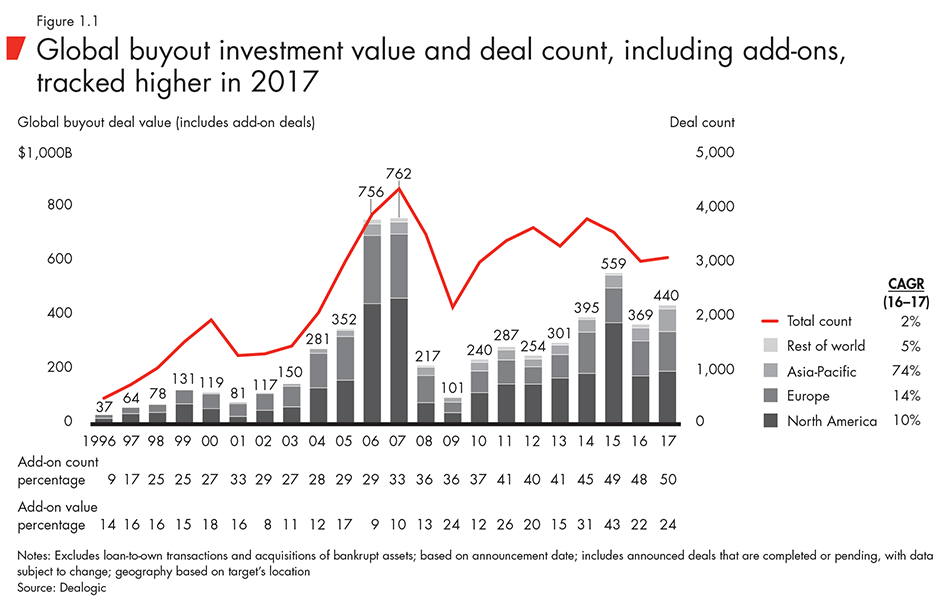
Including add-on transactions, global buyout value grew 19%, to $440 billion, supported by a stream of large public-to-private deals. On the other hand, global deal count was essentially flat, growing just 2%, to 3,077 deals. That’s off 19% from 2014, the high-water mark for deal activity in the current economic cycle.
This disconnect between the value and number of deals reflects a stubborn dynamic affecting deal making in most regions around the world: While funds have ample money to spend, they have too few attractive targets on which to spend it. Investors have allocated more capital to private equity over the past five years than at any time in history, prompting some observers to wonder whether the market is in danger of overheating. In the search for ways to put money to work, however, GPs are hampered by several factors—high valuation multiples, stiff competition and an uncertain macroeconomic outlook that complicates future value calculations. These factors are forcing funds to be selective, and in some cases prompting them to stay on the sidelines. Yet as dry powder, or uncalled capital, continues to accumulate, the pressure to do deals is only building, testing the industry’s ability to maintain discipline.
Regular readers of Bain’s Global Private Equity Report may notice that we’ve included add-on deals in our investment totals for the first time. These transactions, used to acquire assets that are then added on to existing platform companies, are typically excluded from industry value and deal count calculations. Over the last several years, however, they have become an increasingly important part of PE activity. At a time when high prices make it challenging to acquire new platform companies, GPs are gravitating to add-ons for several reasons. Funds can use them to execute buy-and-build strategies that turn a collection of smaller companies acquired at lesser multiples into a large enterprise with a premium valuation. They allow funds to take advantage of synergies to underwrite higher asset prices, and can give a trusted leadership team a bigger set of assets to manage. While add-ons made up around a third of all deals a decade ago, they comprise half the total today. Because add-ons tend to be smaller than platform deals, however, they represent only about 25% of total deal value. Their smaller size, combined with the fact that they are not always purchased with PE fund dollars, means add-ons soak up far less excess capital than platform buyouts.
The expanding size of platform deals, in fact, was the largest factor behind 2017’s healthy jump in global investment value. The size of the average disclosed buyout, excluding add-ons, has been climbing for six years and hit a record high of $675 million in 2017. These large deals punched up value totals in all regions.
- In North America, deal value, including add-ons, rose to $196 billion, mostly on the strength of a number of large carve-outs and public-to-private deals, including Sycamore Partners’ $6.8 billion acquisition of Staples.
- In Europe, several large deals, including the $6.4 billion leveraged buyout of Danish payments firm Nets, led by Hellman & Friedman, boosted value to $147 billion on a 2% increase in deal count.
- Deal value in the UK rose 7%, to $39 billion, despite ongoing uncertainty about how Brexit will affect the nation’s currency and economic outlook. As disruptive as Britain’s exit from the European Union has been, investors appear confident that London’s dominant role in the financial markets augurs well for the UK’s continued place in the global economy.
- Asia-Pacific was a true bright spot for deal making in 2017. Buyout value surged 74% in the region, to $83 billion, propelled by the year’s largest buyout globally—the $17.9 billion carve-out of Toshiba Memory Corp. led by Bain Capital, among others. China and India also produced their share of big deals as a number of large buyout firms turned their sights on the region. Slowing economic growth cooled valuation expectations, raising the number of attractive targets.
A flood of buyout capital
In many respects, these should be the best of times for GPs, as both equity and debt capital are rushing into the market on a flood tide. On the equity side, five years of record-level fund-raising have left the industry flush with capital to spend. Dry powder has been on the rise since 2012 and hit a record high of $1.7 trillion in December 2017 (see Figure 1.2).
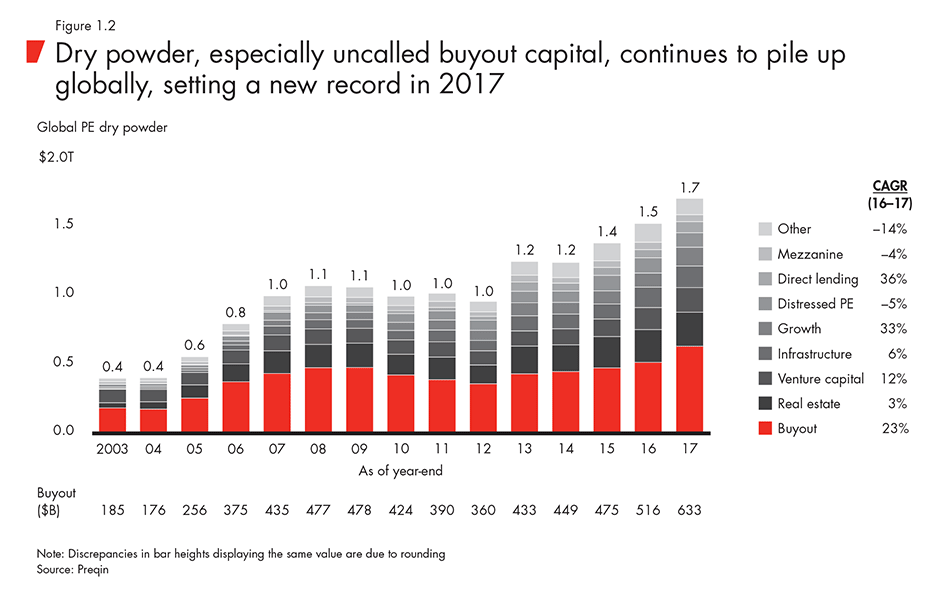
The debt markets, meanwhile, are red hot, offering GPs a golden opportunity to fund transactions with hefty levels of low-cost leverage. The markets for speculative bonds and leveraged loans are as robust as they’ve ever been, as investors clamor for higher yields to augment their returns in a sustained low-interest-rate environment. Although there were exceptions to the general enthusiasm—debt investors balked at an attempt to take Nordstrom private, for example—the strong demand for high-yield paper heavily favored deal makers in 2017. The average debt multiple stretched toward six times earnings before interest, taxes, depreciation and amortization (EBITDA), the level at which regulators begin to pay close attention (see Figure 1.3). And a number of high-profile deals piled on even more leverage. The $4.3 billion buyout of USI Insurance Services led by KKR, for instance, pushed the company’s leverage ratio just above eight times EBITDA, according to Moody’s. That kind of leverage is coming on increasingly easy terms. The number of so-called covenant-lite loans—those with few benchmarks or restrictions for borrowers—has been growing rapidly since 2012 and totaled roughly three-quarters of overall loan volume in both the US and Europe at the end of 2017.
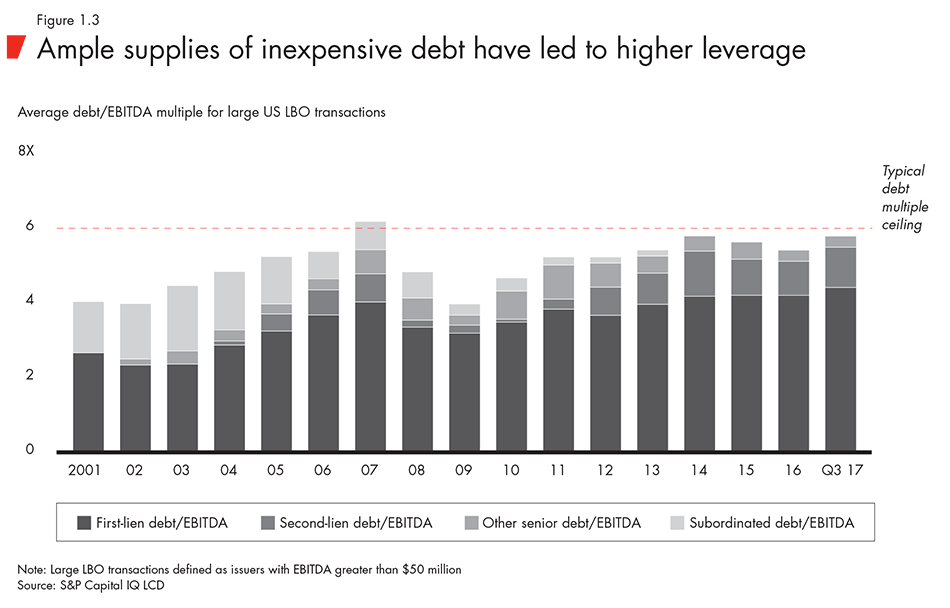
Soaring valuations
If easy money provided an accelerant for deals in 2017, soaring asset prices and fierce competition pumped the brakes on market activity. Average purchase price multiples for leveraged buyouts (LBOs) rose to historic highs, hindering GPs’ efforts to put dry powder to work (see Figure 1.4).
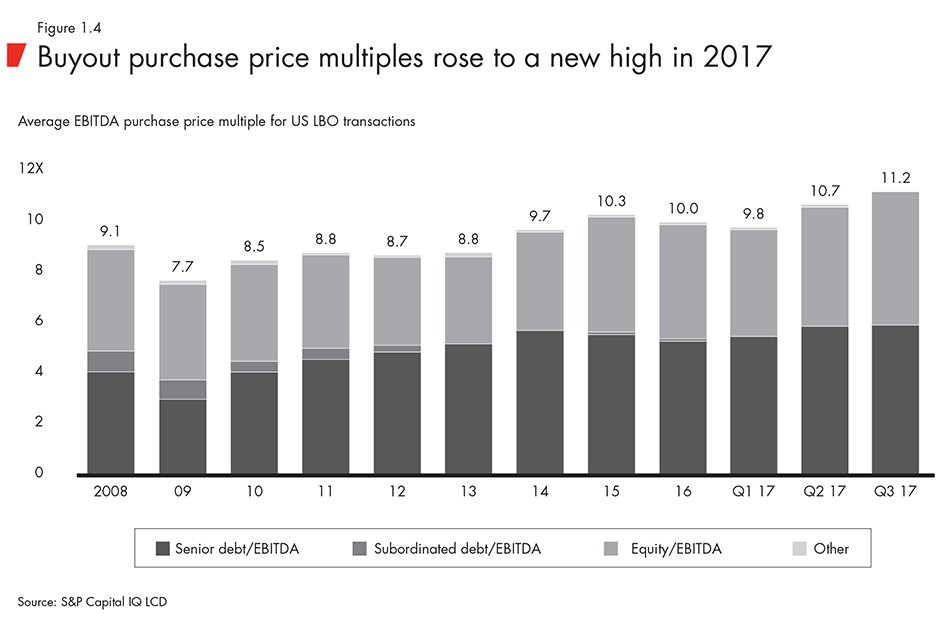
Although lenders and bondholders are willing to fund deals with maximum debt levels, there’s a point at which deal makers run into diminishing returns. As noted, deals that incorporate six turns of leverage begin to attract heightened regulatory scrutiny, meaning the upper limit of borrowing is not far above that. When deal multiples climb, GPs have to make up the difference with more equity. The capital is clearly available, but a higher ratio of equity to debt decreases the deal’s internal rate of return (IRR), making it more difficult to justify.
That is especially true at a time when the macro outlook in the US and Europe raises real questions about how long the global economic expansion can continue. “Every one of our base cases now involves a recession,” Todd Abbrecht of Thomas H. Lee Partners recently told an industry conference. Investors are unlikely to face a downturn in 2018, according to Bain’s Macro Trends Group, but our economists agree with most others that the US economy is highly likely to experience a recession over the next five years. And though Europe’s recovery has unfolded more slowly (meaning it may have longer to run), a recession in the US could easily trigger a downturn on the continent and in the UK.
The cloudy outlook renders it frustratingly difficult for GPs to make assumptions as they put together deal models. Given sustained competition, valuation multiples may not retreat much in the face of slowing economic growth.
Still, it’s hard to expect that further multiple expansion will push a company purchased at 12 times EBITDA today to 15 times a few years from now. Speaking at the same conference as Abbrecht, Alan Jones, coleader of Morgan Stanley Global Private Equity, put it this way: “Our presumption is that we’ll be exiting at smaller multiples. If we’re wrong, it means we planned for a future that was worse than what actually happened.”
Stiff competition
One thing GPs can count on is that competition for assets isn’t likely to abate in coming years. If anything, it may worsen. The number of PE firms hunting deals has risen steadily each year for decades and now totals 7,775 (see Figure 1.5).
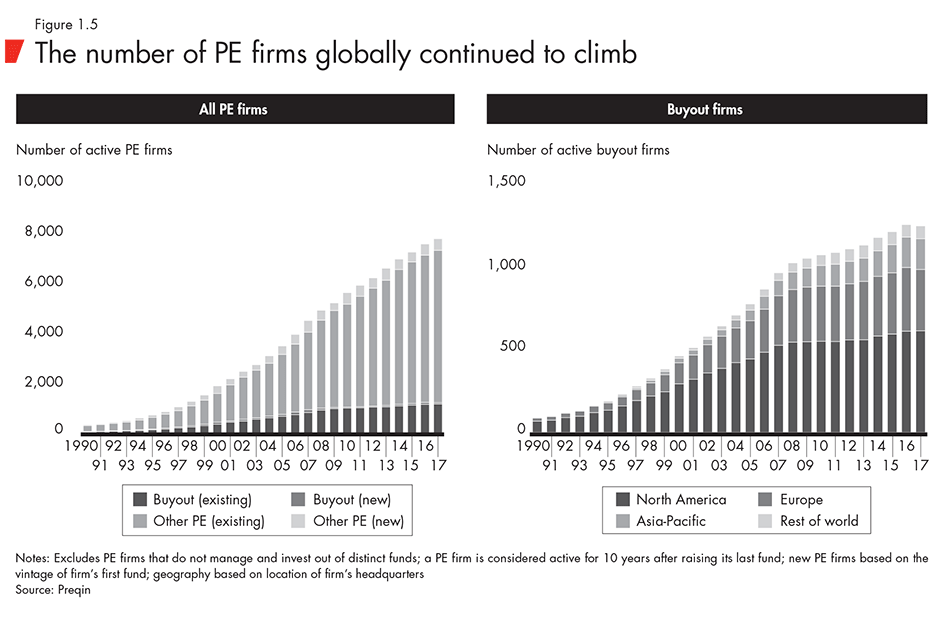
Corporate buyers, meanwhile, continue to scour the world for growth through acquisition, routinely showing up at auctions that involve attractive targets of all sizes. That’s a problem for PE buyers because corporations have several built-in advantages that improve their odds in competitive bidding, including a lower cost of capital and willingness to pay up for synergies or strategic value. Because GPs often lose out in head-to-head competition with corporate buyers (looking at standalone, or platform, assets only), private equity’s share of overall M&A activity globally declined in 2017 for the fourth year running.
The horde of corporate buyers isn’t likely to disappear anytime soon. Flat or slowing economic expansion around the world makes it hard for many companies to achieve organic growth and reach strategic objectives, which means public investors are quick to reward those that generate growth through acquisition. According to Bain research, companies that made 12 or more acquisitions between 2005 and 2015 enjoyed 39% higher shareholder returns than those that made no acquisitions over the same period.
Historically, corporate buyers have tended to ignore acquisition targets that don’t add scale. But that’s changing as company leaders see ways to use acquisitions to serve other objectives, like augmenting product development, acquiring talent and accelerating distribution. Consumer companies struggling to develop new brands, for instance, are increasingly looking for candidates on the outside and plugging them into their portfolios. Think of Conagra’s acquisitions of Thanasi Foods (maker of Duke’s meat snacks) and Angie’s Artisan Treats, or Nestlé’s buyout of Blue Bottle Coffee. Corporate interest in the middle market is especially nettlesome for PE firms that specialize in buying smaller companies, building them to scale and then selling them at a profit to exactly the kinds of large companies they are now trying to outbid at auction
In the past few years, more large companies have borrowed a page from the technology playbook, setting up corporate venture capital (VC) units tasked with investing in companies that might be additive strategically. Tech players like Google, Intel and Dell still account for most corporate VC activity, but companies like Unilever and Kellogg are getting in the game. Overall, the value of corporate VC deals globally has risen dramatically over the past several years, to $51 billion in 2017, and the average deal size has expanded steadily (see Figure 1.6). The number of corporate VC investors remains relatively small, but it has doubled to 262 in the past four years.

For GPs, these trends have made for fierce competition from well-heeled corporate buyers for targets of all sizes. That competition is boosting multiples in the middle part of the market, such that buyers are paying almost as much per dollar of EBITDA for midsize companies as they are for large ones.
The subdued deal activity numbers suggest that, presented with inflated asset prices and easy money, GPs are so far showing discipline. The market has gotten frothy enough that many GPs are wary of doing what may turn out to be a weak deal under pressure. The problem is that waiting on the sidelines poses its own form of risk. GPs that hesitate to put money to work this year may find that conditions are even more difficult in the future.
Searching for pockets of opportunity
How are GPs adjusting to this new normal of steep valuations and unrelenting competition? Firms are getting proactive in pursuing a number of strategies:
- Looking over the hedge. With the number of sponsor-to-sponsor deals on the rise, more PE firms are combing through the portfolios of other funds, looking for promising companies that might be coming up for sale. The practice has been especially popular in Europe, but it also gained steam in North America in 2017. The analysis is fairly straightforward: Given the five-year investment time frame most buyout firms adhere to, GPs scour active portfolios for companies with specific characteristics that have been held for at least three years. Isolating a short list of promising candidates allows firms to get a jump on due diligence. The objective is to be smarter and better prepared than other bidders when the asset comes up for auction.
- Walking among the zombies. One truth about PE funds is that they are notoriously hard to kill. Zombie funds are essentially the walking dead; they have stopped raising new capital but are still working through portfolios. Our definition of a zombie fund is a buyout fund that raised its initial capital between 2003 and 2008 but has not raised capital since and hasn’t executed a buyout deal since 2015. We’ve identified 19 of these funds in North America and Europe, and their holdings of more than 100 companies are plausible candidates for ownership change in 2018.
- Picking up the pieces. Corporate carve-outs accounted for around one in five deals in the US and Europe over the past few years. They should continue to provide steady deal flow for buyout funds thanks to the persistent catalysts feeding the trend—activist shareholders calling for disposal of noncore assets, companies’ own decisions to rationalize, conglomerates looking to get smaller and more focused.
- Taking on a challenging asset. GPs will likely need to sharpen their pencils to underwrite more challenging strategies, like chasing higher growth or tackling a tricky turnaround. Often, that entails building stronger capabilities to manage risk. KKR’s carve-out of Unilever’s spreads business, for instance, will present a challenge given declining consumption of margarine. But the firm will work to turn around years of underperformance and position the business for long-term growth. TPG Capital and Welsh, Carson, Anderson & Stowe also took on a complex deal when they announced that they would team up with Humana to take Kindred Healthcare private for $4.1 billion. Under the deal’s unique structure, the funds and Humana will take on Kindred’s home care business, while carving out the company’s specialty hospital assets as a standalone company. Although the long-term acute care part of the business has been challenged in recent years, the opportunities outweigh the risks for TPG and Welsh, Carson.
- Ramping up public-to-private activity. As we predicted last year, public-to-private conversions are on the upswing. As price-to-EBITDA multiples paid in the private markets converge with valuations in the public markets, more public companies become potential take-private targets. Public companies tend to be bigger companies, and taking them private presents an opportunity for funds to put a lot of capital to work. They are also attractive to lenders, which are eager to finance these mega-transactions. The number of public-to-private conversions in 2017 increased from 2016, and the average deal size jumped substantially. Consequently, the total value of these buyouts surged to $180 billion in 2017, nearly twice the level of the year before (see Figure 1.7).
- That level of value still pales compared with the massive set of take-private deals that preceded the global financial crisis, largely because the consortium arrangements that fueled those deals have fallen out of favor. But more megadeals like JAB Holding Company’s $7.5 billion buyout of Panera Bread or Sycamore’s $6.8 billion Staples buyout are not only possible but also likely to drive substantial deal value in 2018. In an effort to gauge the potential for public-to-private activity in the year ahead, we looked at the universe of US public companies with enterprise value up to $50 billion (a level beyond which a take-private transaction becomes impractical). We identified close to 800 companies trading at multiples of nine times EBITDA or below, making them relatively attractive targets. Screening them further based on potential for revenue and margin expansion, we ended up with 72 US public companies that seem ripe for conversion. For large GPs eager to put big sums of capital to work, the public markets are likely to offer a fertile field in 2018.
- Building through add-ons. An increasing number of firms, especially in North America, are reacting to high multiples among large and larger midsize companies by focusing on the smaller end of the market, because smaller assets tend to sell for lower multiples. For GPs looking to create growth with an existing portfolio company, this presents an interesting opportunity. While the firm may have paid top dollar for the original portfolio company, it can buy growth much less expensively by strategically acquiring smaller companies and integrating them into a bigger platform. The result is a scale company at a lower average multiple. As we explore on page 31, GPs are finding ample opportunity to create value this way in the burgeoning retail healthcare sector (see “Spotlight on retail healthcare: An island of growth”).
- Taking a long-term perspective. Because the usual five-year holding period makes it difficult to take a long-term approach to value creation, a small but growing number of buyout firms are extending the duration of investments. Doing so gives them a longer runway to nurture growing businesses, integrate acquisitions or make transformative change happen (see “Spotlight on long-hold funds: Opening up new horizons” on page 21).

• • •
Exits: More discipline, more value
A quick look at the trend in global exit value and activity in recent years would suggest that, while 2017 was a good time to sell assets, it was nothing compared with the peak years of 2014 and 2015 (see Figure 1.8). Last year’s 1,063 exits, valued at $366 billion, surpassed 2016’s totals of 1,032 and $337 billion, respectively. But 2017 performance still fell well below the peak of $464 billion across 1,302 exits in 2014.
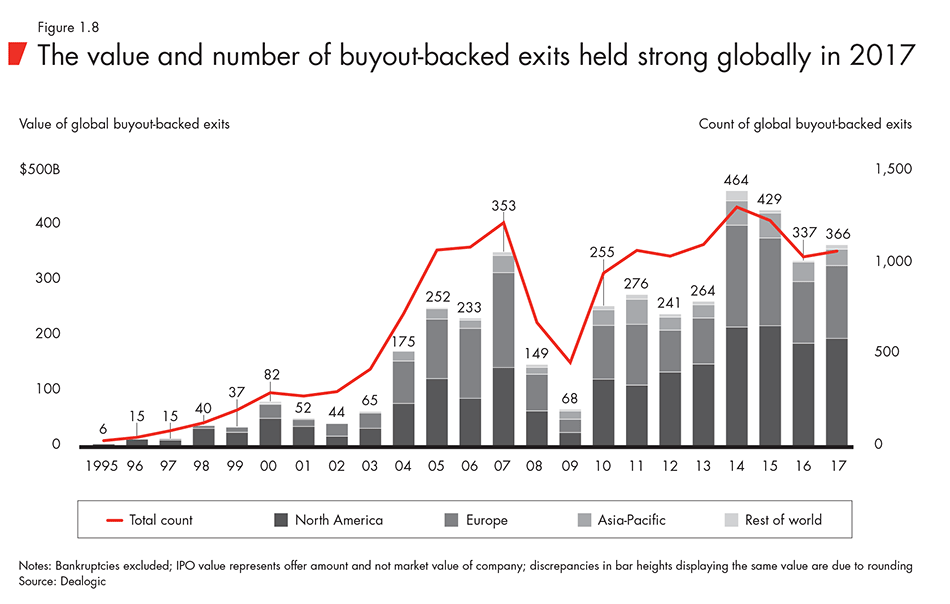
What those headline numbers don’t reveal is that the post-2015 drop-off was to be expected. The earlier spike in exits came as GPs cleared a burdensome backlog of companies purchased before the global financial crisis—investments that had suffered during the turmoil and took years to recover. By 2017, the dynamic was healthier; more than 80% of the exits involved companies PE firms had acquired from 2009 on, generally a stronger crop. The year produced a number of standout deals, including The Carlyle Group’s $3 billion sale of Nature’s Bounty to KKR, and the $2 billion sale of Ascend Learning by Providence Equity Partners and the Ontario Teachers’ Pension Plan to Blackstone and the Canada Pension Plan Investment Board. Sellers saw strength across channels and geographies.
North American buyout-backed exit value and count rose 5% and 8%, respectively, as value settled at $197 billion across 498 transactions. Europe, which saw some weakness in initial public offering (IPO) activity and a 4% decrease in exit count, still managed an 18% gain in buyout-backed exit value, reaching $132 billion. In Asia-Pacific, buyout-backed exit value dropped by 16%, to $30 billion, but that tells only part of the story. Asia-Pacific GPs rely much more heavily on investments in growth companies and those in the public markets. Including sales of minority stakes in private companies and shares of publicly traded enterprises, Asia-Pacific exit value increased 18%, to $115 billion, on a 40% increase in the number of transactions, to 710, according to AVCJ.
Working harder to create value
As strong as the exit environment was in 2017, the data also suggests that PE firms are working harder and longer to create value. In last year’s report, we noted that holding periods for companies in PE-fund portfolios were settling into a new normal of around five years. The five-year median in 2017 only strengthened that conclusion. During the industry’s precrisis heyday, the median holding period for portfolio companies was less than four years, and PE firms were exiting around 40% of all buyout-backed deals in less than three years (see Figure 1.9). More recently, those “quick flips” have retreated by half, to around 20%.
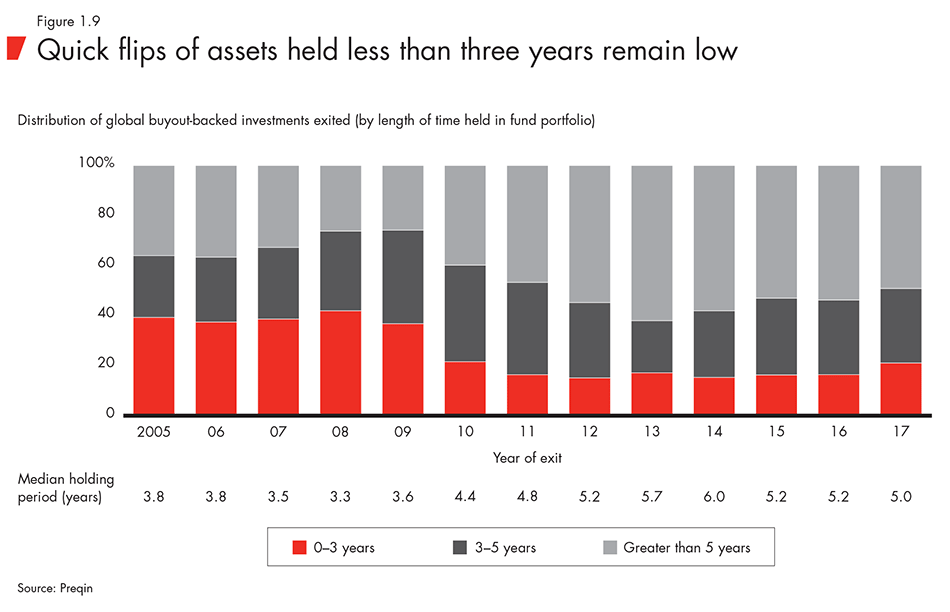
That isn’t to say quick flips aren’t possible in today’s deal markets. Indeed, a successful exit in 2017 was CVC Capital Partners’ $1 billion sale of Paroc Group to Owens Corning. CVC had owned the Finnish insulation materials company for just three years, but saw an opportunity to sell it to an acquisitive corporate buyer looking for a solid strategic match in terms of geographic footprint, technologies and product offerings. Quick deals like that one, however, are the exception. In an era of high prices and limited future market beta, generating strong returns usually takes more time. Tax reform has also changed the calculus in the US. Under the new law, carry generated from investments held for three years or less will be taxed at the higher ordinary income rate rather than the lower capital gains rate. Previously, the threshold was one year. Due to these factors, the era of quick flips is unlikely to return in the foreseeable future.
In an effort to ensure that they are exiting companies at the optimal time and generating the best return, a growing number of GPs are taking the exit decision out of the hands of the managing directors who found and nurtured the deals. Instead, they are forming exit committees to bring a more objective and disciplined approach to exit strategies and timing. HgCapital, which formed what it calls a realization committee, is giving the group just as much influence over exit decisions as the firm’s investment committee has over investments. Whereas deal executives once made all the exit decisions, the firm now asks the realization committee to vet and approve exit strategies. The goal is to be more deliberate about preparing a company for exit and more calculating about taking advantage of opportunities as they arise.
A seller’s market
PE funds found ample opportunity to sell in 2017. The high multiples and stiff competition for deals that are making it so challenging to find attractive acquisition targets often present sellers with multiple strong options for a successful exit (see Figure 1.10). AEA Investors’ $500 million IPO of Evoqua Water Technologies is a good example. As the firm was preparing a public offering, which valued the company at around $2 billion, Reuters reported that Evoqua fielded a $2.5 billion all-cash offer from Xylem Inc., a US-based water technology provider with a strategic interest in the company. In the end, AEA chose the IPO route, assuming the company would ultimately trade higher in the public markets than the multiple of 13 times EBITDA that Xylem was offering. The valuation of Evoqua did, in fact, quickly surpass the Xylem offer.
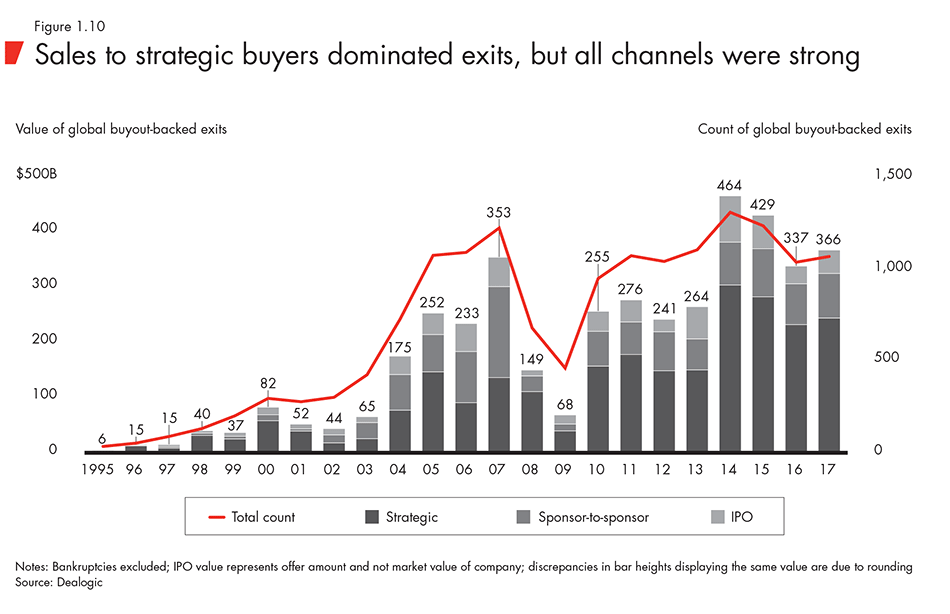
Sales to strategic acquirers and other sponsors. Though Xylem lost out on the Evoqua deal, corporations with strategic intentions and pockets full of cash continue to be avid buyers of PE assets. For companies like Unilever, buying growth is an essential part of strategy. In 2017, the Anglo-Dutch company quickly expanded its skin-care business in North Asia when it paid $2.7 billion for Carver Korea, a company controlled jointly by Bain Capital and Goldman Sachs since 2016. Crown Castle International roughly doubled its wireless infrastructure business—and produced the year’s biggest buyout-backed exit transaction—when it bought LTS Group Holdings from Berkshire Partners, Abry Partners, Pamlico Capital and HarbourVest for $7.1 billion.
Sellers are also benefiting from the heated competition among PE firms looking to put record amounts of dry powder to work. The second-largest channel for exits by value in 2017 was sponsor-to-sponsor sales, which give the new owner an opportunity to take a company through its next act of value creation. GPs also like the fact that PE-owned companies have already been subject to some management rigor. For example, Leonard Green & Partners agreed to buy CPA Global, an intellectual property services company, from London’s Cinven for $3.1 billion. Not only was Leonard Green confident it could help CPA embark on a new phase of expansion, but it also knew that Cinven had already spurred double-digit EBITDA growth in the company’s core IP business.
Public markets. Buyout-backed IPO activity made a big jump in 2017 after a particularly poor showing a year earlier (see Figure 1.11). Following heavy volatility in early 2016, the channel benefited from more stable markets globally, especially in North America, where IPO value nearly doubled its 2016 level. One exception was Europe, where the market suffered somewhat from economic uncertainty across the continent and continuing Brexit turbulence.
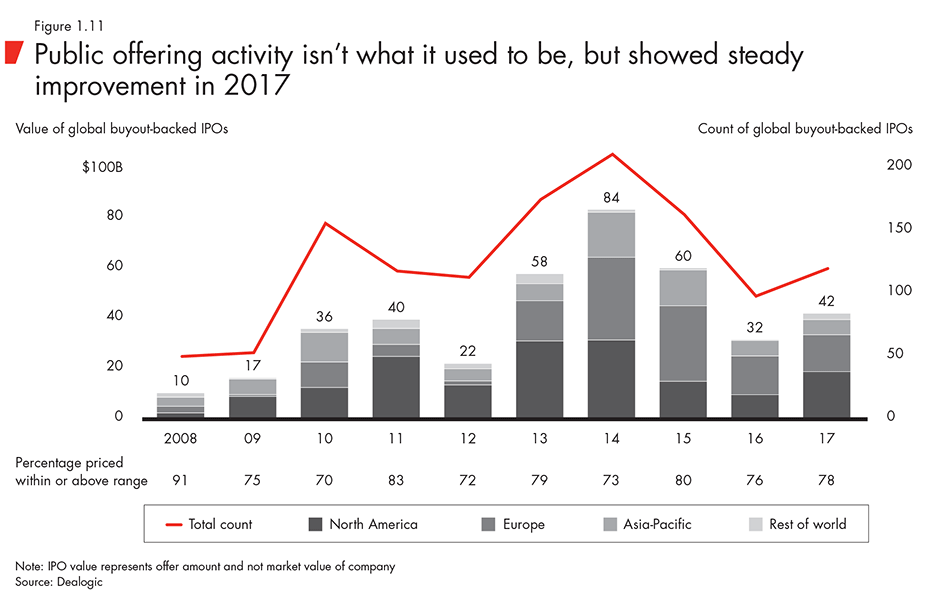
IPOs continue to lag globally compared with the boom period from 2013 to 2015, when PE funds took advantage of strong stock market gains to exit a number of big companies—several of which were taken private before the global economic crisis and brought public again afterward. While IPO count and value in 2017 didn’t benefit to the same degree from this type of mega-IPO, markets were still very receptive to IPOs from companies making their public market debut.
It’s also important to recognize that the top-line IPO exit number isn’t everything when it comes to public exits. As we emphasized last year, an IPO typically makes up only a small portion of a PE firm’s total stake in a company. Due to mandated holding periods and market timing considerations, a firm usually holds a large share of its investment past the initial offering, unwinding it more slowly in transactions that aren’t counted in the exit numbers. TSG Consumer Partners, for instance, took its Planet Fitness health club chain public in 2015 but didn’t completely exit the investment until 2017, when it sold an additional $325 million in stock. Taken together, global IPO and follow-on value came in at $129 billion in 2017. Of that total, follow-on value amounted to $87 billion, or 67% (see Figure 1.12).
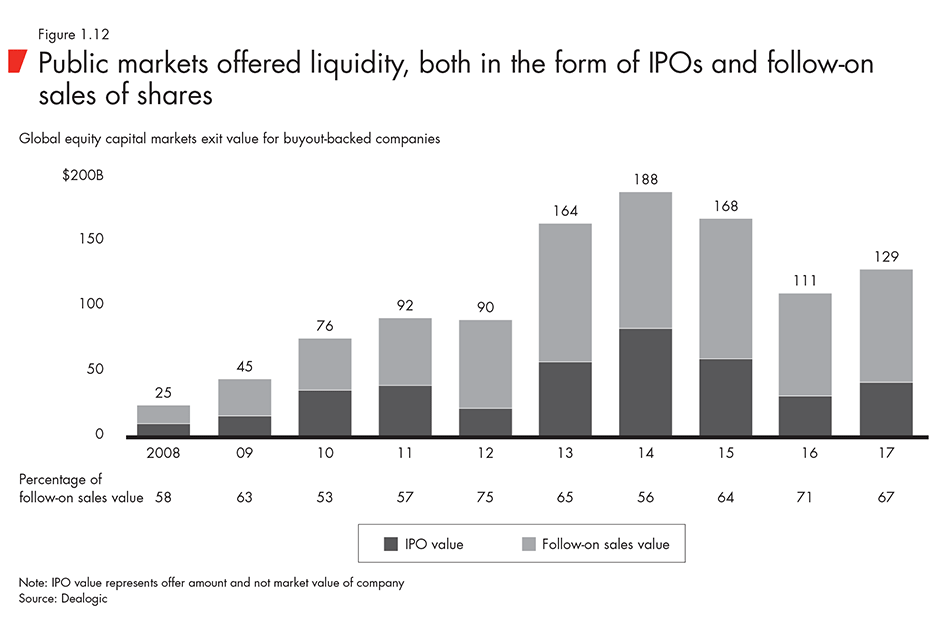
Dividend recapitalizations. Exit numbers also fail to capture transactions in which a portfolio company takes on debt, often to fund a dividend for investors. In the US, dividend-related loan issuance to sponsor-backed companies totaled around $42 billion in 2017. The practice is highly dependent on an accommodating debt market. But when the market demand for high-yield paper is strong, it can provide a compelling incentive to borrow capital, take money off the table and de-risk the investment. Platinum Equity’s $4 billion leveraged buyout of Emerson Electric Co.’s network power business (subsequently renamed Vertiv) illustrates how heated these markets were in 2017. Less than three months after closing the initial leveraged transaction, Platinum cashed out about a third of its $1.2 billion in equity when Vertiv took on a new $500 million high-yield leveraged loan.
Partial exits. Selling a stake in a company—but keeping a hand in the game—is another trend that gained currency in 2017. Often, a company’s upside potential will outlive a PE firm’s payback timeline. These so-called partial exits allow a GP to declare victory on a deal and return capital to investors, but still retain a stake in a company that is likely to keep growing and generating returns. Given how hard it is to find new deals and redeploy capital, it is also in the GP’s interest to stay invested in a known quantity. Berkshire Partners found itself on both sides of this trend in 2017. As a buyer, the firm took a majority stake in Accela, a provider of government software solutions, while the seller, Abry Partners, remained an investor. On the other side of the ledger, Berkshire sold a stake in Access to GI Partners, while remaining a significant investor in the records and information management services provider.
Barring any unforeseen shock, global economies are expected to continue their expansion in 2018 and perhaps beyond, which likely will mean favorable exit conditions in the near term. But GPs are hardly being complacent. The aging economic cycle suggests these conditions won’t last forever, and PE firms will continue to seek opportunities to lock in their gains sooner rather than later.
• • •
Fund-raising: The good times roll on
Last year, the headline of this portion of the Global Private Equity Report read, “Fund-raising: As good as it gets.” Turns out 2017 was just as good. PE firms raised $701 billion globally over the course of the year, capping an astonishing five-year stretch during which they raised more than $3 trillion in capital from investors (see Figure 1.13). Buyout funds have led the pack in fund-raising, but the persistent flow of investment has benefited almost every PE sub-asset class and geographic region.
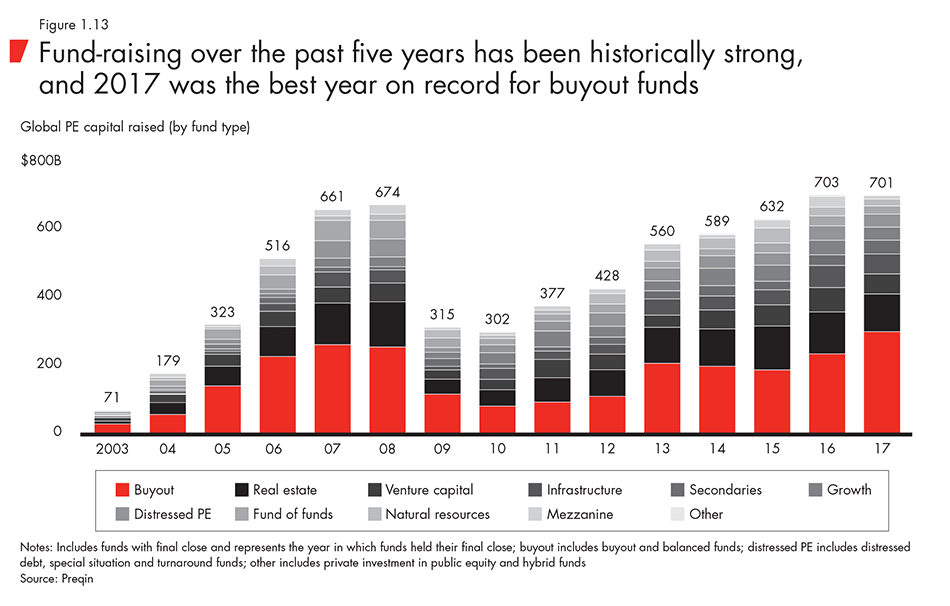
Annual fund-raising data can be lumpy because it only counts capital once funds hold a final close, no matter how long they’ve been on the road. But there’s no denying the strength of the five-year trend. PE funds have attracted significantly more capital since 2013 than during any other five-year period in history—including the frothy five years preceding the global financial crisis. While some investors are starting to question whether the extended surge in capital is a sign that the PE markets are getting too hot, surveys indicate that LPs remain committed to the asset class and its promise of superior returns. For 95% of LPs, returns from private equity have met or exceeded expectations. As of midyear 2017, the median net return of PE holdings in the portfolios of public pension funds over a 10-year time horizon was 8.5%, compared with 4.2% for public equities, 4.5% for real estate investments and 5.2% for fixed income. That kind of outperformance is irresistible in a period marked by persistently low yields on most other investment options.
Investors had plenty of funds to choose from this past year. The number of funds on the road and the size of their capital targets continued to climb in 2017. The aggregate level of capital sought by PE funds was $1.9 trillion, or 19% more than in 2016, and the amount sought by buyout funds alone was $452 billion, or 8% higher than the year before (see Figure 1.14). Despite heavy competition from the growing number of funds on the road, GPs had striking success in their fund-raising efforts. Overall, more than two-thirds of PE funds that closed in 2017 met or exceeded their target amounts, and 39% took less than a year to close. Among buyout funds, the success rate was even higher: 85% met or exceeded their targets, and a full 68% closed in less than a year.
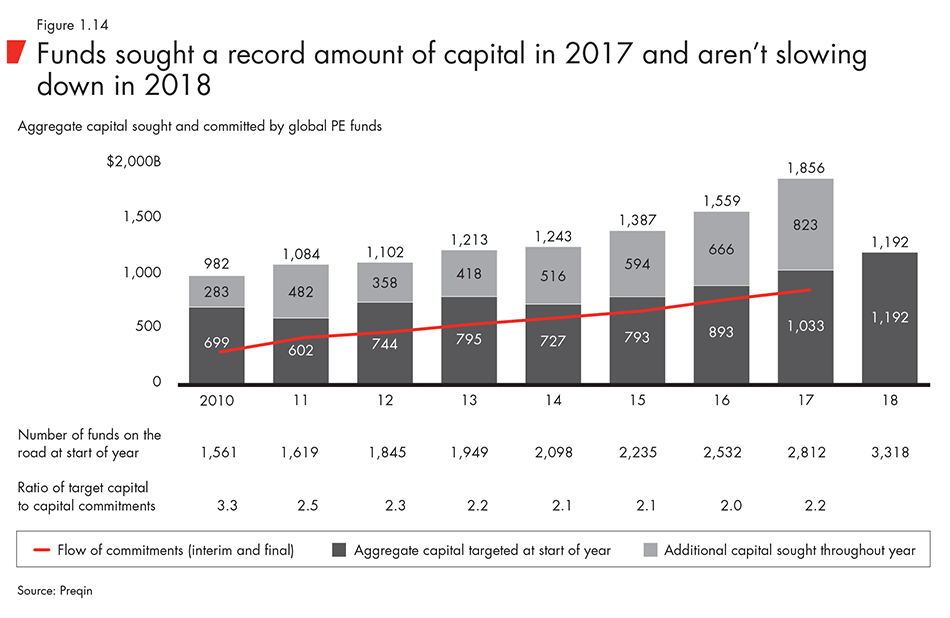
Enduring confidence
LPs are watchful for signs that global markets are overheating. But given the industry’s historical performance—and the almost unanimous expectation among market analysts that private equity will continue to outperform other asset classes—most investors say they will stay the course with their PE allocations. The most recent survey by Preqin, which provides data on alternative assets, shows that 92% plan to devote the same amount of capital or more to private equity in the coming 12 months, and 96% say they plan to maintain or increase their PE allocations over the longer term (see Figure 1.15).

The arithmetic of maintaining or increasing allocations helps explain the recent surge in fund-raising activity. Strong returns from global equity markets over the course of 2017 increased the value of institutional investors’ overall portfolios, expanding the “denominator” of the PE allocation equation. At the same time, LPs continued to receive strong cash flows from their PE investments. Globally, distributions have exceeded contributions for buyout funds each year since 2011, and the ratio has been holding around 2-to-1 since 2013—meaning that, for every $1 put to work, around $2 comes back (see Figure 1.16). Despite increasing valuations of portfolio assets, the overall net asset value of PE holdings, the “numerator” in the equation, did not grow for many LPs. Consequently, PE’s share of their total portfolio assets contracted in 2017. That encourages LPs to keep plowing their gains back into the market in an attempt to maintain their target PE exposure.
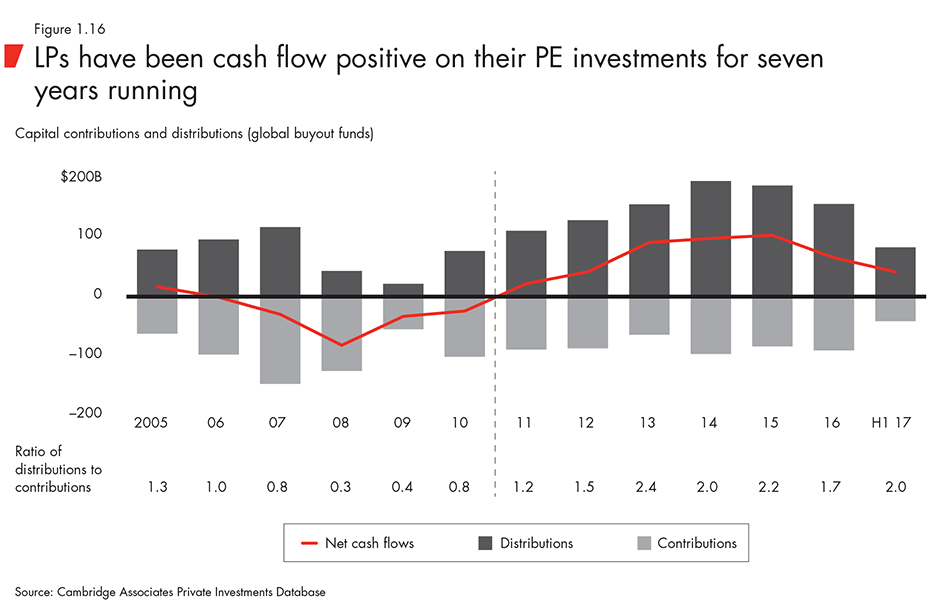
Even amid the flood of capital from traditional sources—public and private pension funds, endowments, sovereign wealth funds, insurance companies and so on—GPs are actively seeking new sources of demand for their services. Blackstone, Carlyle and Apollo Global Management, for instance, are developing ways to court more ultra-high-net-worth individuals, with plans to work their way down the line to high-net-worth individuals, accredited investors and, ultimately, the mass retail market through 401(k) accounts. Regulation and other hurdles await, but executives at these firms have made it clear that they see individuals and retail investors as the industry’s next engine of growth. Blackstone took a step in that direction in 2017 when it announced an aggressive push into products targeting individuals with $1 million to $5 million available to invest. The Wall Street Journal laid out the logic: There were seven-and-a-half times more investors with $1 million to $5 million at the end of 2016 than there were investors with $5 million to $25 million (a group that already has access to Blackstone funds).
The mega-trend continues
As investors pile capital into the market, PE firms are raising ever-larger funds. The trend toward megabuyout funds discussed in last year’s report only gained steam in 2017 (see Figure 1.17). The $24.7 billion Apollo Investment Fund IX was the largest single buyout fund raised in history. The $18 billion (€16 billion) CVC Capital Partners Fund VII was the largest euro-denominated fund ever raised. KKR’s $9.3 billion Asian Fund III was the largest-ever Asia-focused buyout fund, which is especially notable since the region has not been a buyout market historically. Overall, megabuyout funds—those with more than $5 billion in assets—raised a stunning $174 billion in capital in 2017, or 58% of the year’s buyout total. Those numbers represent a steep increase from the $90 billion and 38% logged in 2016.
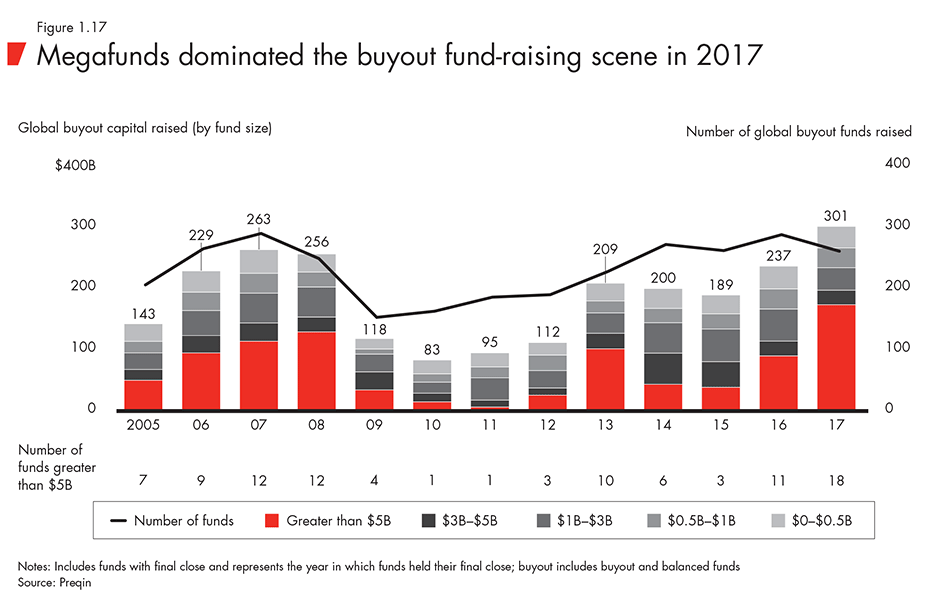
As one measure of the extraordinary investor enthusiasm in 2017, all 10 of the largest funds closed during the year raised more than their targets, and they easily could have raised even greater amounts. Consider that CVC initially set an ambitious target of $14.5 billion for its Fund VII, but demand was more than double that, surging past $30 billion. CVC eventually capped the fund at $18 billion, or 126% of its original target. In a telling sign of just how bubbly the market has become, Reuters reported that CVC responded to the heavy demand by cutting its hurdle rate—or the fund’s minimum promised rate of return—from 8% to 6%.
This rush to size is slightly puzzling considering that, when surveyed about which fund types they consider to be of most interest, LPs consistently rate megafunds well below other categories. Yet for massive institutions with huge amounts of capital to place, a megafund is an attractive and efficient way to put money to work. While megafunds did bear the brunt of the global financial crisis, over time they have exhibited comparable performance to other buyout-fund size classes with less volatility. Big-name firms like KKR, Apollo and CVC also have impeccable track records, and large institutions are lining up to invest with them.
First-time appeal
The truth is, the flood tide of capital sloshing around global markets is raising all boats—including a number of very large first-time funds. In 2017, 319 first-time PE funds closed globally, including 9 funds of $1 billion or more. Two of the largest first-timers were Core Equity Holdings I, which raised $1.2 billion with a focus on Western Europe, and the $1 billion Cove Hill Partners Fund I, focused on North America. Both of these buyout funds offer a long-term hold strategy, which is emerging as another key trend in the industry (see “Spotlight on long-hold funds: Opening up new horizons” on page 21).
Betting on an unproven manager is a risk and requires intensive due diligence, but performance data shows it can pay off. Managers of these funds are motivated to build a solid track record, and they actually outperform follow-on funds, delivering the same or higher median net IRR in most vintage years. First-time funds also offer LPs a chance to establish relationships with new managers perceived to have strong potential. That’s important as more and more LPs struggle to get the allocations they need with proven performers. In response to a Preqin survey conducted in late 2016, 43% of LPs said they would consider investing in first-time funds.
A hazy period for GP selection
There’s little doubt that GPs view this period of heated investor enthusiasm as a strike-while-the-iron’s-hot opportunity. They are racing to launch new funds well before their predecessor funds have matured. A look at the 20 largest buyout firms globally shows that the gap between closing one fund and starting another has compressed to 40 months, from 62 months five years ago. Given the standard five-year investment period for buyout funds, PE firms generally wait about four years before going back to investors for more capital. But in the current environment, they are knocking on the door much sooner.
For LPs, the compressed time frame between closings requires a leap of faith, since there’s no real way of knowing how well a fund is doing just three years after the close. The latest research by global investment firm Cambridge Associates on private investments benchmarking shows that it takes at least six years to get a reliable picture of a fund’s return trajectory (see Figure 1.18). In 86% of cases, buyout funds move through three or four different performance quartiles before they settle at their final level of performance relative to others. Assessing a fund’s performance track record is an important part of an LP’s due diligence, especially when fund sizes are growing rapidly at a given firm. Running a $2 billion fund isn’t necessarily the same thing as running a $5 billion fund.
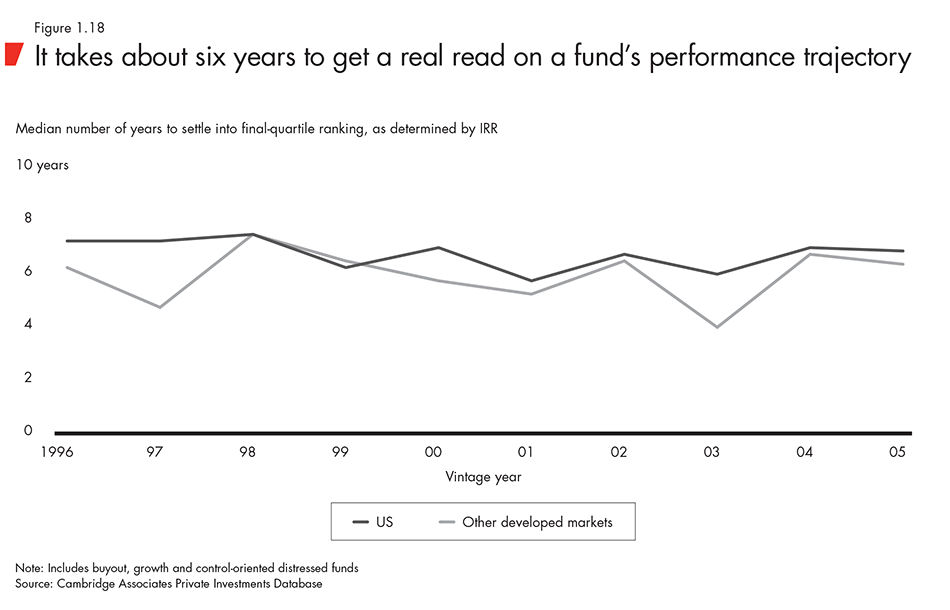
Another factor making diligence of GPs difficult today is that more funds are taking advantage of the ready availability of cheap debt to manage cash flow with lines of credit. This is a legitimate tool to smooth out capital calls and enable funds to move quickly to close deals on short notice. Yet because bridge financing has an inevitable effect on the traditional measurement of IRR, it muddies the waters when comparing fund performance. To start, not all funds use lines of credit. Second, the impact on a fund’s IRR is asymmetrical depending on the timing of cash flows.
Just how big is the impact on IRR? Oliver Gottschalg, a professor at HEC Paris and a founder of analytics firm PERACS, analyzed cash flows for 95 liquidated buyout funds from the US and Europe, vintages 2000 to 2003. Simulating bridge financing, he pushed back drawdowns for each fund by 90 days. The results showed IRR increases of less than 300 basis points for a large majority of funds in this scenario, but IRR for about 1 in 10 funds in the sample increased by more than 500 basis points. Due to the asymmetrical impact on performance, the bridge financing pushed 12% of funds in the sample into a higher-quartile ranking. These effects highlight how the rise in fund-level credit facilities hinders LPs seeking a clear view of performance across funds. The industry is now actively working to strip out the effects of bridge financing on performance measurement.
Capturing the outperformance of private equity is predicated on an LP’s ability to separate the best from the rest. For all of the reasons we’ve just discussed, however, they have their work cut out for them. As capital pours into the asset class, LPs are competing fiercely to put their money to work with a limited number of top GPs, and they are facing challenges in evaluating performance. At the same time, the GPs that have raised a record amount of capital face their own challenge: Amid a dearth of opportunities, they must find ways to put a flood of capital to work and deliver on the promises they’ve made to investors.
Spotlight on long-hold funds: Opening up new horizons
Buyout firms typically aim to acquire companies and sell them profitably within three to five years. But that relatively short duration generates recurring costs for the funds and the LPs that invest in them, as well as recurring hunts for new assets by GPs. In recent years, a growing number of investors have decided to put some of their money in longer-term investment vehicles. Such patience presents an opportunity to generate higher returns on committed capital over the long haul, Bain’s analysis shows.
Several large PE firms, including CVC, Carlyle and Blackstone, have been launching buyout funds with longer lives. Blackstone raised $5 billion for a fund with expected holding periods roughly double those of the traditional buyout fund. Two first-time funds, Core Equity and Cove Hill, also raised more than $1 billion each in short order, with anticipated holding periods of up to 15 years.
Two main types of long-hold funds have come to market. “Core” buyout funds target portfolio companies with lower risk and lower return (the name is a riff on the so-called core infrastructure funds that cover the lower risk/lower return end of the infrastructure spectrum). CVC’s Strategic Opportunities fund has a 15-year life span and targets an IRR of 12% to 14% while charging lower fees. Its first investment, in UK roadside-assistance operator RAC Group, exemplifies the type of stable, low-growth assets that fit the core buyout fund model.
Another type of fund, which we call a long-hold buyout fund, targets risk/return profiles, as well as fees, in line with traditional buyout funds. For this type of fund, investors don’t need to sacrifice a measure of returns in exchange for longer duration. In fact, each type of long-hold fund offers several advantages:
- Lower transaction costs, such as taxes and consultant fees, associated with buying and selling businesses
- Fewer distractions for portfolio company management
- Fully invested capital over longer periods and with less time waiting to be reinvested
- Deferred taxation of capital gains, allowing capital to compound over time
- More flexibility on the investment horizon, allowing funds to sell an asset at the optimal time
- Access to companies looking for patient capital, such as founder-led businesses that need capital to grow
Bain recently modeled costs and returns for a theoretical long-hold fund selling an investment after 24 years, vs. a typical buyout fund selling four successive companies over that period. If the fund’s portfolio company performs in an equivalent manner during this period, by eliminating transaction fees, deferring capital gains taxation and keeping capital fully invested, the long-hold fund outperforms the short-duration fund by almost two times on an after-tax basis, our analysis shows (see Figure 1.19).
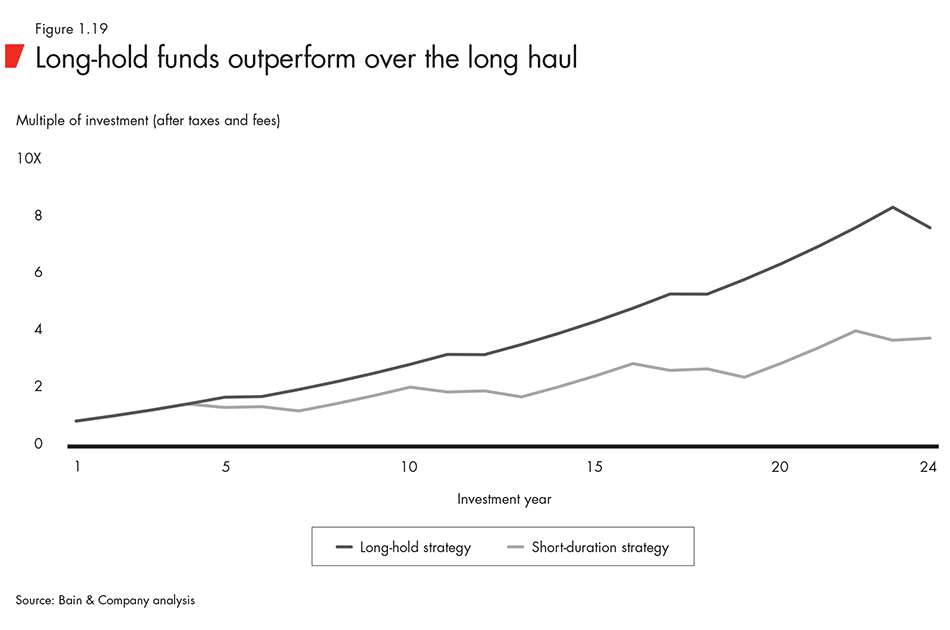
Not all assets lend themselves to this strategy—distressed properties, turnaround candidates or economic-cycle plays need not apply. To meet their IRR targets over a sustained period, long-hold funds typically seek inherently high-quality companies that are well positioned to compound EBITDA over a long time frame, with strong management, strong free cash flow, high relative market share and/or the opportunity to gain share. These businesses might be disrupting an industry and can take market share over an extended period, or have long tailwinds based on customer demographics like an aging population. Company size is less important than that strategic profile. To get a sense of how many companies might fit in a long-hold strategy, we looked for businesses that were owned successively by at least three PE funds. Reviewing deals globally over the past two decades, we found more than 500 such companies.
How can investors ensure that they calibrate their risk underwriting correctly? Investors seeking to hold assets over a long period need a clear view of the duration risk that exists in most industries, as technology, regulations and competitive threats can change quickly. Re-diligence of portfolio companies on a regular basis, perhaps every three to four years, provides an updated understanding of industry dynamics and the competitive positioning of the asset. Shifting risks or opportunities inform the hold or sell decision. If the duration risk gets too high, pull the rip cord and sell. If the answer is to hold, then adjust the plan in order to keep creating value.
Long-hold funds are becoming compelling to GPs and LPs alike. However, one alternative model outside traditional private equity appears to be maximizing the benefits of long-term investments: professionally managed private capital holding companies. The Cranemere Group, a London-based private holding company founded by a former CEO of AEA Investors, exemplifies this model. Cranemere’s primary investors include family offices and sovereign wealth funds, which seek strong returns on their capital, not short-term distributions.
Cranemere designed its structure specifically to allow investors to capture the benefits of a long-term approach. Investors become shareholders, not LPs, in the holding company. Most of Cranemere’s management team and board of directors are shareholders as well. Shareholders have controlling governance rights that ensure alignment between investors and management. With no set investment mandate, as with a typical GP/LP relationship, the strategy can evolve over time. If investors want liquidity, they have an option after their capital is fully called: They will be offered an opportunity to sell shares annually within a certain window of time, based on mark-to-market valuations by an independent third party.
Having a permanent capital base means assets can be held indefinitely, with no need or incentive to exit an investment before it makes sense. It also leads to tax efficiency, as Cranemere is not required to distribute capital back to investors. Cash generated by a portfolio company goes first to the Cranemere holding company, not to shareholders, so there is no capital gains tax and the capital can be reinvested. Moreover, management can make attractive long-term investment decisions that would be harder to justify with a holding period of only three to five years.
Given that long-hold funds have just started to emerge in the marketplace, it’s too soon to say how much capital they will ultimately attract. But for institutional investors (especially taxable investors) with long investment horizons, steering some capital to long-hold funds makes sense. For one thing, to compete with corporate buyers in M&A, especially for large assets, PE firms may need to act more like corporations and extend the duration of their investments (see “Beating corporate buyers at their own game” on page 67). Doing so would give them more time to integrate add-on acquisitions and transform the assets. And for GPs that spend most of their waking hours either raising funds or buying and selling assets, having the flexibility of more years to hold and nurture great assets could be a welcome change.
Returns: Strong momentum, but for how long?
Buyout funds delivered another year of strong returns in 2017, reflecting both robust exit markets and gains in the valuations of portfolio holdings. For the 12 months ending in June 2017, US buyout funds posted a 17.3% end-to-end pooled net IRR, while buyout funds in developed Europe delivered an even healthier 22.2%. Buyout and growth funds in Asia-Pacific posted a 13.2% return.
As strong as these results were, they could barely keep pace with the rousing performance of the public markets over the same period, especially in Asia-Pacific. After a tough start in 2016, public markets around the world benefited from a better-than-expected and synchronized global economic expansion that kindled the spirits of stock market investors. Using the modified public market equivalent (mPME) metric developed by Cambridge Associates, which replicates the timing and size of PE cash flows (both purchases and sales) as if they had been invested in public equities, it is possible to make apples-to-apples comparisons between PE and public equity returns. On that basis, the S&P 500 returned 17.9% for the 12 months ending in June 2017, and the MSCI Europe turned in 18.2%. The MSCI AC Asia Pacific, meanwhile, shot up a whopping 23.2%, almost doubling PE funds’ performance in the region.
These short-term comparisons are interesting but not particularly useful in evaluating PE performance. At the same point last year, after all, private equity outpaced the public markets by a wide margin on an mPME basis. The problem with such comparisons is that public markets are prone to wide swings up and down over a period of months, whereas PE-fund portfolios, which are subject to mark-to-market accounting, experience much more modest quarter-to-quarter movements. Private equity is a long-term, illiquid asset, which means that single-year performance shouldn’t be all that relevant to investors.
Over longer time horizons, however, it is clear that private equity continues to outperform public markets around the world (see Figure 1.20). The gap has narrowed somewhat as the PE industry matures and becomes more competitive, putting pressure on average returns. But comparisons with public markets over the long term demonstrate why the asset class has such enduring appeal. Looking at the 10-year period ending in June 2017, US buyout funds in aggregate returned 9.7% vs. a 7.9% return for the S&P 500 indexed using mPME. Funds in developed Europe returned 8.7% vs. 3.6% for the MSCI Europe, and Asia-Pacific buyout and growth funds posted 10.5% vs. 4.5% for the MSCI AC Asia Pacific. Looking forward, the broad consensus of economists and forecasters assumes that PE’s outperformance will continue over the next decade and beyond.
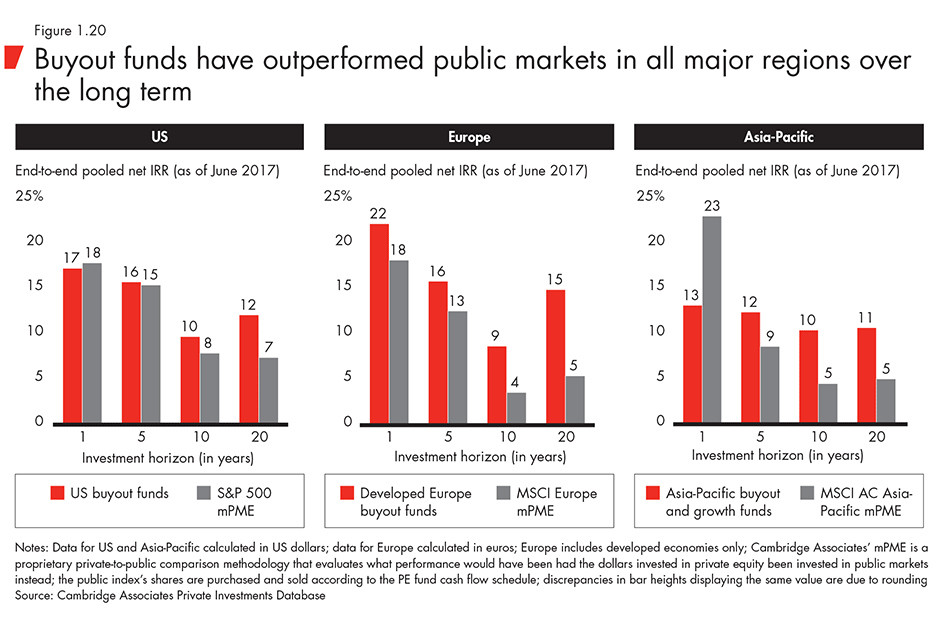
The goal of most investors is not to capture average performance, of course, but to beat it by consistently allocating capital to the best-performing funds in the market. On that basis, the opportunity for outperformance in the PE asset class is even greater. Over a 10-year horizon, the pooled net IRR for top-quartile funds in the US and Europe was 17.1% and 14.3%, respectively, as of June 2017, far outpacing the industry and public market equivalents (see Figure 1.21).

Are PE returns replicable in public markets?
One question that often arises is whether it is possible to replicate PE returns in the more liquid public markets. A financial instrument that did so would definitely be in high demand. For one thing, it might let investors avoid the headaches of PE investing—including high fees, illiquidity and the challenge of securing allocations in funds of top-performing managers. Given the industry’s struggle to put mountains of dry powder to work, publicly traded products that approximated PE performance would also give LPs and GPs a place to park capital at an attractive return while waiting for capital calls or searching for deals.
Unfortunately, it is not possible to fully replicate PE-level returns in the public markets, largely because PE investors have tools at their disposal that aren’t readily available to investors in public markets. There are three basic components of PE outperformance. The first is alpha—the ability to improve a company’s performance relative to its peers. Second is leverage—the practice of using debt to magnify the returns of equity. Finally, there is sector selection—picking sectors that will outperform the broad public markets.
There is no mechanism in the public markets to replace creating alpha, the value generated through active management of a portfolio company. It is possible to use debt to enhance the returns of public equities, but it rarely makes sense, practically speaking. The performance of public markets is often insufficient to support the cost of debt, and margin calls are a constant threat. That leaves sector selection, which, according to recent analysis by Oliver Gottschalg using Cambridge Associates buyout data, doesn’t add meaningful value on average.
Average is the key word there, though. In fact, a number of PE firms are able to generate value by consistently targeting sectors that outperform the broad markets. This outperformance can add up to an advantage of approximately 250 to 300 basis points—enough that several financial firms are developing products to capture it. State Street’s Liquid Private Equity Investable Index is a good example. Based on a proprietary data set and quantitative methodology, the index seeks to replicate the portion of private equity’s excess return over public equity attributable to sector selection by investing in sectors that closely track US buyout fund performance.
State Street says the index is a liquid proxy for direct PE investment, but not a substitute. It explicitly does not capture the illiquidity premium or company-specific alpha that GPs provide. That said, back-testing the index’s performance as if it had existed from 2002 through 2016 shows that it would have outperformed the S&P 500 9.2% to 6.8%, with less risk. State Street developed the index as a cash-management tool for institutional investors looking for interim exposure to PE-like returns in the period between committing capital and having it called down and put to work. At a time when dry powder is at record levels, such a strategy could help ease periods of “cash drag,” when idle capital can slow down overall performance.
Looking forward
Facing persistently high asset prices, a record flood of new capital and extraordinary levels of competition, it’s not surprising that both GPs and LPs are scratching their heads and wondering how long the bullish markets—and robust returns—can last. The broad consensus is that 2018 will be a solid year from a macroeconomic standpoint, supported by strong fundamentals. Beyond that, the picture gets hazy.
An analysis by Cambridge Associates, however, suggests that the current economic cycle is already producing fewer of the home run deals that really drive PE performance (see Figure 1.22). The chart compares post-recession levels of return coming out of the past two downturns (with the proviso that results for 2014–15 are still far from fully baked). The good news is that there have been fewer write-offs and deals experiencing capital impairment in the post-2009 period than in the years after the 2001 recession. At the same time, there have been fewer really good deals in the wake of the global financial crisis. From 2002 to 2005, 35% of the deals produced returns of three times invested capital or better, and more than half generated multiples of two times or better. From 2010 to 2013, those figures were 20% and 42%, respectively. Many factors are at play behind these numbers, but they support the idea that the M&A market’s steady rise in multiples is limiting opportunity to generate the kind of returns the industry has grown used to.
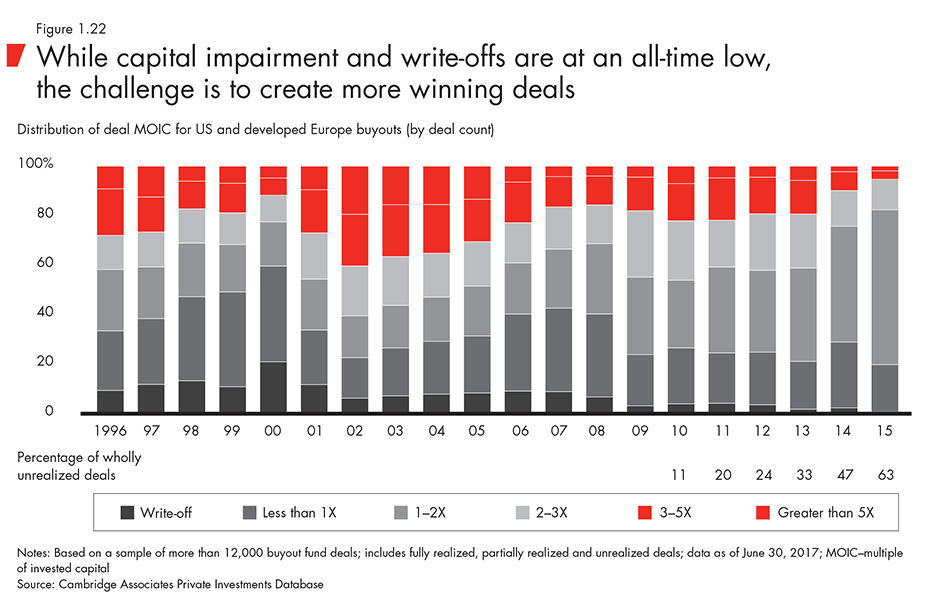
In many ways, this is to be expected. Microeconomics tells us that, with more and more capital searching for a limited number of quality assets, prices will rise and returns will tend to fall off over time. Eventually, they should reach a normative level, which is probably public market returns plus an illiquidity premium to account for the fund locking up the capital for a period of years.
It’s important to recognize, however, that this isn’t happening in a vacuum; all asset classes are under pressure in the current environment, and few expect public equities to perform in coming years as they did in 2017. A significant portion of the returns for all equities over the past 30 years has stemmed from multiple appreciation linked to the extraordinarily low level of interest rates. The broad consensus is that rates will remain flat or trend upward from current levels. As they do, asset multiples should stay put or trend downward in unison.
Even as fund returns ease off over time, the emphasis among investors is evolving from absolute returns to relative returns. That means investors are evaluating PE investments less on the basis of “What absolute-percentage IRR did the fund deliver?” than of “What percentage did it deliver relative to the public markets, and was it enough to justify holding my money for a period of years?” In that context, private equity as an asset class will likely continue to outshine others, as it has for decades.
For funds to thrive in a hotly competitive environment, however, the aspiration has to be much higher than that. As in any industry, tracking to the mean is a recipe for mediocrity. The firms with the best strategies and talent will always outperform the rest and offer investors a powerful way to augment their portfolios. Winning, then, is about fighting back against that downward trend with better insight and execution. The highest absolute returns are still about the hunt for the top quartile.
Key takeaways
- Global buyout deal count was essentially flat in 2017, up just 2%, while deal value increased 19%, to $440 billion, reflecting the growing size of the average disclosed deal. For the first time, we included add-on transactions in our investment comparisons, as they now represent half of the buyout deal market by count. Low-cost debt financing was readily available, and GPs were sitting on record levels of dry powder—$516 billion earmarked for buyouts at the start of 2017. Soaring valuations amid stiff competition for assets, especially from corporate buyers, made it very difficult for PE firms to find and win deals.
- The same forces that complicated deal making in 2017 made for a great time to exit. Buyout-backed exit value came in at $366 billion, the third-best year ever, while exit count rose 3%. All main exit channels—sales to strategic buyers, sponsor-to-sponsor transactions and IPOs—produced increases in both count and value globally. The median holding period for buyouts remained steady at five years. Thanks to the robust debt markets, dividend recaps continued to be a favored strategy for taking some money off the table sooner rather than later.
- “As good as it gets” conditions for fund-raising persisted throughout 2017. The $701 billion of PE capital raised globally nearly matched the high-water mark set the previous year. Buyout funds led the pack, capturing $301 billion, a staggering 27% increase over 2016. This total benefited from the record number of megabuyout funds that closed during the year. Given a growing denominator and continued strong flow of distributions from PE-fund portfolios, LPs were eager to commit more capital to their best-performing asset class in an effort to maintain their target PE allocations.
- Looking at a short-term time horizon, buyout funds delivered strong returns. Uncharacteristically, however, public markets had a similarly strong run. This was a temporary phenomenon owing to recent strength in global stock markets, and these short-term swings don’t mean much. With returns across asset classes likely to come under pressure, investors are shifting their focus from absolute returns to relative returns. Over longer time horizons, private equity continues to outperform public markets around the world.
Spotlight on retail healthcare: An island of growth
The biggest challenge facing PE investors for several years running has been finding attractive investment opportunities. But amid the resulting pressure on deal activity, one sector has been conspicuous in its growth: retail healthcare.
From 2012 to 2017, the number of deals involving retail health companies—those that operate freestanding health-related outlets like dental clinics or urgent care facilities—has soared, increasing at a compound annual rate of 34% in the North American market (see Figure 1.23).

Interest in retail health has expanded beyond a niche set of investors. The success of firms like Audax Group, Abry Partners and Summit Partners has caught the attention of a broad range of players—from large, diversified funds like Warburg Pincus to institutional investors such as OMERS and Teachers’ Private Capital. Atlanta-based Roark Capital Group jumped into retail health in 2016 when it acquired Great Expressions Dental Centers, a chain of more than 260 branded dental offices. Roark was betting that its experience building multisite retail and service businesses like Jimmy John’s and Meineke would pay off as Great Expressions rolled up smaller chains to take advantage of a growing dental brand.
Ample upside
Much of retail health’s appeal is that it is a fragmented, high-margin sector with strong growth characteristics. In a sea of high prices, it still offers targets at reasonable multiples and many opportunities to unlock substantial value.
The playing field includes a wide range of health services, from urgent care and dental to physical therapy and dermatology. What these companies have in common is a heavier reliance on consumer choice than many healthcare services, meaning that some thrive less on insurance reimbursement and more on self-paying patients. They tend to be multisite businesses emphasizing proximity to customers, and many offer specialized care, allowing them to standardize and replicate treatment protocols across sites.
How dependent they are on consumer choice varies widely. A chain of veterinary clinics, for instance, will tend to rely heavily on direct payments from customers, while a dermatology outlet typically has a mix of revenue sources. Patients might pay for cosmetic procedures out of pocket, and their choice of provider might depend largely on social media reviews or recommendations. But patients with skin diseases or cancer tend to come from physician or network referrals, and payments are largely insurance based.
Whatever the mix, revenue growth—both current and potential—is central to retail health’s appeal. The sector has been growing at a steady 3% to 4% annually, and it is clearly benefiting from trends in the healthcare industry that encourage cost management and greater patient choice. The rise of urgent care clinics, for instance, stems from the fact that these proliferating outlets provide a strong alternative to emergency rooms for both payers and patients. An aging population with growing health issues, higher incident rates and increased focus on wellness and prevention also supports long-term revenue growth. Moreover, that growth is likely to be recession-resistant. As with other health-related businesses, much of the sector’s revenue comes from need-based services that remain steady despite fluctuations in economic activity.
While this level of secular growth is attractive, the opportunity to help retail health businesses perform substantially better also exists, through a combination of smart organic growth strategies, building new outlets and acquisitions. New outlets deliver a very high return on invested capital. Opening a site may trigger an investment of between $200,000 and $300,000, but operators can recoup that amount quickly, leaving a healthy stream of future cash.
Similarly, a buy-and-build strategy gives PE investors the chance to arbitrage multiples that historically have expanded with a company’s growing scale and clout. While retail health businesses with fewer than 10 outlets have been commanding multiples of around four to seven times EBITDA, those with 10 to 50 clinics are selling for seven to nine times, and some marquee assets with more than 50 clinics are trading in the low teens. The opportunity to magnify value through consolidation is huge. And with all areas of retail health still highly fragmented, there is no shortage of acquisition targets (see Figure 1.24).
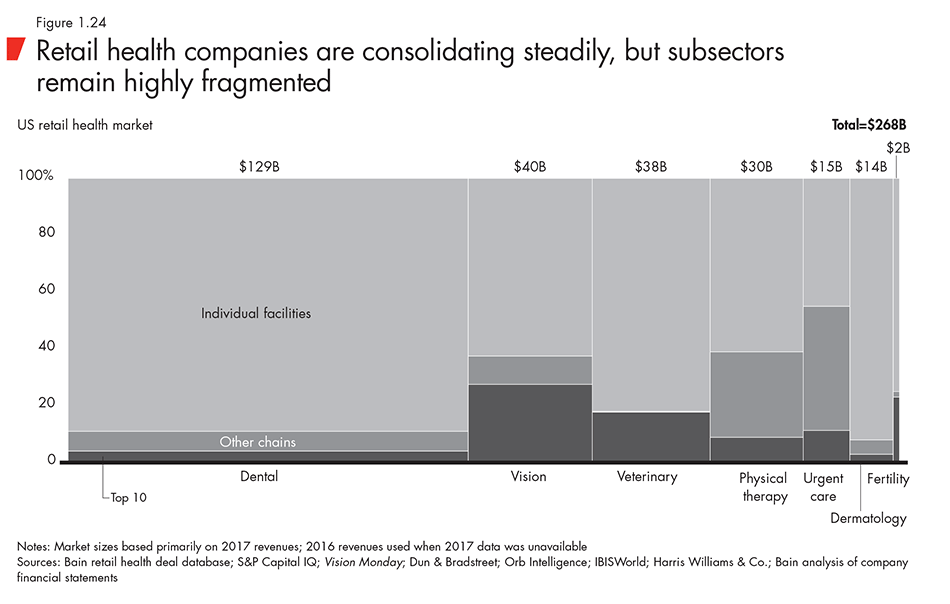
This calculus was at the forefront of Harvest Partners’ 2014 recapitalization of Athletico Management Holdings, a chain of physical therapy and rehabilitation outlets. A licensed physical therapist named Mark Kaufman had founded the company in 1991 and expanded it organically by slowly building new outlets in the greater Chicago area. The company had consistent performance, a favorable mix of payers, strong cash flow and a management team focused heavily on clinical excellence. What it didn’t have was M&A expertise or capital to ramp up expansion. Harvest brought both when it invested an estimated $400 million in the company.
Harvest’s vision was to build Athletico from a Chicago-focused PT provider into a superregional platform. That required bringing in acquisition talent and creating a dedicated “de novo” team that quadrupled the number of new outlets opening annually. It also meant solidifying the operating model and infrastructure needed to support a larger organization. Within six months of the original investment, Athletico acquired rival Accelerated Rehabilitation Centers from OMERS Private Equity, more than doubling the size of the business and expanding its scope throughout the Midwest. That set the stage for a quick exit: In December 2016, Harvest sold the company to Chicago-based BDT Capital Management, collecting a strong return on its original investment.
Multiple paths to value
Top-line growth in the retail health sector also comes with potential for exceptionally high profitability. Before accounting for corporate overhead, individual retail health clinics typically enjoy EBITDA margins of around 25%, and those can spike as high as 45%. Even so, PE funds see significant upside potential in a sector that is still taking shape. Mature, ultracompetitive industries like traditional retail have been managed aggressively for years. Investors and management teams have already pulled many of the levers available to boost results—supply chain optimization, procurement, category management and so forth—making it difficult to capture yet more value. In a typical retail buyout, the company might have to undertake a dozen initiatives in pursuit of less than 100 basis points of margin improvement. In retail health, firms are discovering that just a couple of key value-creation initiatives can demonstrably improve the company’s economics.
The best playbooks deploy a combination of retail and healthcare best practices. Retail investors bring expertise in real estate management, site selection, branding and marketing. They use a consumer mindset to home in on target customers and best meet their needs. Healthcare specialists tend to attack the operations side of the business by improving clinical workflow, optimizing billing practices and improving negotiating power with payers and suppliers. The ability to run plays from both directions can be a meaningful advantage in assessing and realizing potential.
Whatever playbook investors undertake post-acquisition, success hinges on clinician buy-in. Physicians and other clinicians play a major role in the management of these companies and add significant value. They are motivated by a range of factors, not just greater profitability. People who have devoted their careers to a practice need to know that a PE playbook isn’t focused solely on financial performance, but also on delivering better outcomes for patients. This likely will include a plan for improving the patient experience and quality of care. It might involve strategies for bringing in new talent or increasing both professional and office staff to handle new volume without bottlenecks.
Diligence matters
Investing in the retail health sector, of course, carries its own set of risks. Success at this intersection of retail and healthcare most often requires insights developed in both industries. The ability to create a clear and compelling deal thesis becomes especially important as asset prices in the sector edge upward. The PE firms that have the most success focus closely on a number of key factors in their due diligence:
- Growth blueprint. Growth through consolidation and geographic expansion is a consistent investment theme in the retail health sector. But success depends on forging a specific strategy based on local circumstances. Harvest saw the opportunity for Athletico to grow organically by forming an internal team of specialists to open new outlets. But the real game changer in terms of scale was the acquisition of a major regional player that complemented Athletico’s footprint and ambitions. The most successful firms use the due diligence phase to explore specific questions. Are there obvious acquisition candidates, and does the company have the ability to execute and integrate effectively and repeatedly? Are the dynamics in potential expansion markets similar to those where the company already operates? Is the company staffed with a competent business development team, or is that a barrier to expansion?
- Strong operating platform. Successful expansion also depends on the presence of an operating platform that can meet the opportunities the market presents. The basics need to be there or installed—things like effective billing systems, financial and operational reporting procedures tied to the right metrics, and strong network contracting relationships. It’s possible to shore up an operating platform, but that can take time and investors can’t always afford to wait.
- Store economics. Like any retail-related business, these companies thrive on increasing traffic and same-store sales, not just site expansion. Potential investors need a detailed understanding of what drives growth in same-store sales, what factors promote patient advocacy and what sort of operational economies turn more traffic into higher profitability.
- Customer segmentation. It is impossible to be all things to all people. Retail health companies must be able to segment their customers and cater to the most valuable. This requires a deep understanding of patient needs, as well as insight into local market dynamics and an honest analysis of the company’s competitive position. The importance of these factors varies by retail health concept. Direct competition, for instance, affects an urgent care outlet differently than it does a dermatology clinic. It can also vary by market or geography.
- Clinician retention and recruitment. As noted earlier, clinicians are critical to these businesses. Losing them is a serious risk that investors have to consider when building a value-creation strategy. Even if a PE fund can get comfortable with retention, recruitment can prove to be a challenge. Failing to hire the proper number of physicians to support organic growth and the addition of new outlets can turn into a bottleneck.
- Reimbursement and regulatory risk. It’s a standard concern for healthcare investors: How will potential changes to the reimbursement or regulatory scheme affect margins or the size of the addressable market? The risk involved varies depending on each company’s balance of out-of-pocket and insurance payments. But a thorough understanding of how these factors might affect future revenues is critical to assessing the return potential, especially given the real uncertainty around the future of the Affordable Care Act and the ongoing role of Medicare and Medicaid.
The next wave
As in any hot sector, stories of retail health success have drawn more activity, which inevitably puts upward pressure on multiples. It’s not surprising, then, that some investors have begun to search for opportunity in less obvious corners of the industry.
Prospecting has drawn attention to companies like orthodontic implant centers, specialist pet hospitals and high-end concierge medical clinics. A good example is Audax Private Equity’s 2017 rollup of two women’s health companies in Pennsylvania and New Jersey. The new company, branded Axia Women’s Health, operates more than 50 clinics providing OB-GYN, mammography, fertility and general women’s health services.
Retail health is even less mature in Europe and Asia-Pacific than it is in the US, and it is evolving at different rates in different markets. The UK and Nordic markets have seen the greatest proliferation of retail health deals, but a slight relaxation of regulation in Germany should spur increased activity there. India and Australia are leading the way in Asia-Pacific, although China also has produced a number of buy-and-build scenarios. Activity in Asia-Pacific has trended toward ophthalmology, dental, primary care and “health checkup” clinics. In Europe, the emphasis is on dental practices, veterinary care and ophthalmology.
While it’s natural for investors to look further afield as the market gets more crowded, our view is that the retail health sector in North America offers ample opportunity. Even the most traditional retail health businesses are ripe for consolidation and value creation. Consider the market for dental service organizations.
These groupings of dental offices, which contract with individual practitioners to provide a variety of business management and technology services, have signed up only around 11% of the total number of dentists in the US. Similarly, only 18% of veterinary clinics are currently part of a chain, indicating that around 25,000 are still independent. Indeed, most segments remain highly fragmented, leaving plenty of openings for further consolidation.
That sort of outlook is rare across the current PE landscape. At a time when PE funds are awash with capital but lacking appealing targets, a sector as vibrant as retail health is bound to attract an increasing amount of attention.
2. Creating value from the inside out
The prevailing conditions for deal making in the coming years—heavy competition, stubbornly high asset prices and the threat of an eventual economic downturn—present PE funds with a clear imperative: Dial up the firm’s ability to create portfolio company value through better leadership and execution, or accept middling returns. The margin for error in underwriting value has narrowed markedly in recent years as sources of market beta have dried up, increasing the onus on funds to develop strategies that produce growth and margin expansion.
We’ve identified three areas in which top performers are building important new capabilities to thrive in this difficult environment. First, they are honing their leadership assessment skills, learning to identify the right team early and fill roles with fit-for-purpose talent, from the C-suite to the front line. Second, they are recognizing the importance of generating top-line growth by helping companies build world-class commercial capabilities. Finally, they are learning to fight through the hype surrounding digital to sort out how new technology can transform the due diligence process and how companies can use it to create value during the holding period. The firms that can master these skills are those most likely to outperform the averages, as producing top-tier returns becomes harder each year.
• • •
Fit-for-purpose talent: Matching leaders to mission-critical roles
It’s axiomatic in private equity that great management teams can do great things. Portfolio company outperformance is strongly correlated with having the right team in place at the outset, especially at a time when achieving superior returns requires generating profitable growth. Finding talent capable of delivering on the investment plan is challenging but essential, especially when the deal thesis requires a fundamental shift in strategy or operating model. Yet in our experience, PE firms struggle to make early, high-impact talent decisions, both in the C-suite and in other mission-critical roles.
PE investors tend to take an overly positive view of management teams early on in the investment process. When Bain recently analyzed a set of troubled deals in which it had coinvested, it found that the pre-close view of management teams was strong, or at least passable, most of the time (see Figure 2.1). This isn’t unusual. Deal steams spend months courting company leaders through the due diligence and negotiation phases, a period that typically gives way to a post-close honeymoon, when funds might be inclined to give leaders a chance to prove themselves. This relationship is often central to the fund winning the deal, and it can be hard to pivot quickly from “wooing mode” to “operator mode” post-close. Hesitation, however, can be a major source of value loss, as it too often results in unplanned replacements to course correct for suboptimal performance. With asset prices especially high today, funds simply can’t afford indecision around assessing talent and finding the right team.
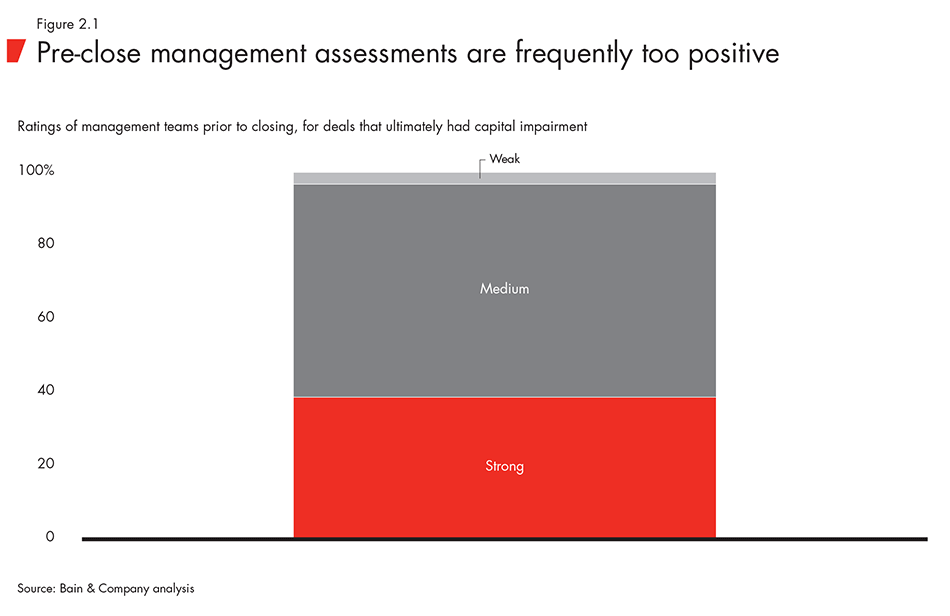
Besides quickly ensuring strong leadership at the top, funds must define and fill the mission-critical roles throughout the organization that are essential to execution. Success depends on matching talent to the unique set of opportunities identified in the value-creation plan. There are typically five key elements of this process:
- Determining during due diligence the capabilities required for the organization to deliver on the investment thesis
- Defining the mission-critical roles and capabilities needed to execute on the plan, identifying any holes in the organizational structure that require immediate change or enhancement
- Assessing the talent needed to win and identifying the right candidates, using traditional tools, advanced analytics or a combination of both
- Creating fast feedback loops to understand what is working and what still needs to be fixed
- Building a continuous learning platform by archiving and analyzing data for future talent decisions within the portfolio
The good news is that it’s becoming easier for PE firms to improve their success rates. Not only are they getting earlier access to management teams in due diligence, but they can also tap new sources of data and take advantage of digitally enhanced assessment techniques to gain better insights. Assessment specialists are increasingly attuned to the needs of PE investors and are becoming more sophisticated at analyzing the growing body of talent and organizational data. Matching these tools and techniques to the specific objectives laid out in the investment plan can result in faster and better talent decisions.
Value creation as the roadmap
When it comes to creating value with a portfolio company, what worked in the past won’t necessarily work in the future. Good leadership is situational. Strategy frequently shifts under PE ownership, and so do the capabilities required for success. What made for good management in the past may be less effective as the new strategy begins to unfold.
This perspective shifts the central question in assessment from “Is this management team good enough?” to “Is this management team fit for our purpose?” A team that performed admirably in one context may not have the right capabilities, experience or style for what comes next. Thankfully, through due diligence, “what comes next” becomes sufficiently clear to determine if the current team can lead the business forward. If the deal thesis is predicated on growth through M&A, for instance, then business development and financial skills rate highly. If the challenge is to spur organic growth, the leadership team should have experience with commercial excellence issues like customer segmentation, salesforce effectiveness and pricing efficiency. If costs are the focus, key capabilities might include sourcing, supply chain and operations expertise.
Even without full access to leadership, a clear view of these critical capabilities helps the PE firm use the diligence period to evaluate the existing team’s strengths and weaknesses. And increasingly, new data sources and analytics tools allow suitors to take a much deeper look into an organization from the outside than ever before. In one recent auction situation for a struggling industrial company, a bidder determined that the company’s sales team wasn’t performing as well as that of the target’s main competitor. To find out why, the firm used web-scraping technology to compare the backgrounds of the target company’s salespeople vs. the rival’s team. The difference in profiles was striking (see Figure 2.2).
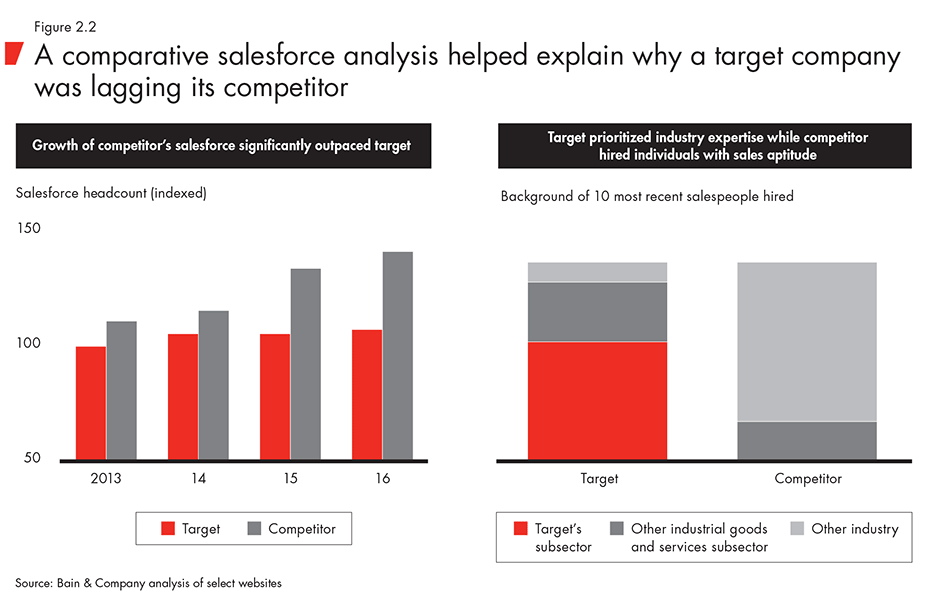
The competitor hired younger, more aggressive sales types who were good at hunting for new opportunities and adept at selling a diverse set of products. The target company, meanwhile, prided itself on deploying engineers and product experts who had been trained to sell based on deep product knowledge.
These approaches reflected a fundamentally different sales philosophy. The target company believed that technical expertise and relationship-building skills should drive sales, and therefore tried to find both in one individual.
The competitor viewed sales and engineering support as two separate roles and sought out the best of breed in each area of expertise. Clearly, the latter approach was winning. With organic growth through new accounts a core pillar of the value-creation plan, the bidding firm concluded that unlocking value would mean either hiring more aggressive sales specialists or creating an analytics team to generate more and better live leads for the company’s engineers-turned-salespeople.
Mission critical from top to bottom
Matching talent to the specific needs spelled out in the value-creation plan has to take place at all levels of the organization. Armed with the clearest possible view of the objectives, the PE firm can define roles that are critical to the mission, from the executive suite to the front line, and create a process for finding the right people to fill them.
For obvious reasons, this begins at the top. The CEO’s skills and temperament must match the deal context. While each CEO has unique motivations, proven strengths and development opportunities, top executives can be categorized into a range of archetypes, such as commercial executor, financial value driver and corporate entrepreneur. The objective is not to bend the value-creation plan to the talent at hand but to find the person best suited to lead the change.
The CEO also needs to understand and accept what it means to work with PE partners. Private equity deals are on the clock, and that necessitates a different, sometimes foreign, mindset. Leaders need to bring a sense of urgency and strike a balance between short- and long-term goals that will ensure the deal’s success. A PE approach is more analytical and less tolerant of sacred cows or business as usual. A leveraged environment requires a high degree of financial acumen. While changing out the CEO is a common occurrence in buyout deals, it is not necessarily a prerequisite for success. What matters is that the incumbent or a replacement is fit for purpose, and that the fund makes the right call early in the investment period.
All of this came into play in 2016, when the deal team for a large activist PE firm sat down for the first time with the leader of a target industrial company. The company had been carved out of a much larger corporate parent, and the deal thesis involved accelerating organic growth by shifting the customer mix and focusing resources on more lucrative segments. Almost immediately, it became clear that the man across the table wasn’t up to the job. A lifer at the parent company, he had landed in the former division’s top spot with limited knowledge of market dynamics. More important, it wasn’t evident that he had the skill set or inclination to oversee the required transformation of the company’s commercial capabilities.
The solution was to reach outside the company to hire an aggressive executive who had worked for a direct competitor and had a solid track record of growing and reshaping a business from the inside out. He demonstrated a sure grasp of what needed to be done at the spin-off to improve performance, and his view meshed with the deal team’s that the entire company needed a talent upgrade. In fact, a condition of his hiring was that he could bring with him a new head of HR and organizational design. He knew coming in that he would need someone who could manage the process of defining and filling new roles. Completely reshaping the C-suite became central to improving the company’s performance.
A fit-for-purpose C-suite
One important benefit of finding a strong CEO is that he or she may be able to help build out the top team. A-level players often bring A-level talent along with them. But a buyer can’t always count on that. When a fund is enamored of a great CEO, the tendency is to assume that the rest of the team he or she has assembled is just as great. That can be a trap unless the fund submits the C-suite roles to the same rigorous assessment and validation process it applied to the CEO. In a PE context, it is essential to define the C-suite roles carefully, so that they align with the company’s new mission and strategy. The mantra here is the same: What changes are required to ensure that the new team is fit for purpose? That might mean creating roles that didn’t exist before or eliminating others. It might require re-scoping or reshaping roles to focus on new imperatives.
When a PE firm purchased a global information services company in a sponsor-to-sponsor transaction, it established in diligence a well-defined path to value: refine the go-to-market strategy, develop new products, and tap new technology to improve the collection and delivery of data and services. Because the company had never built the organizational infrastructure to match its growing size, most decisions bubbled up directly to the CEO; the firm didn’t have the capacity to handle these initiatives. So the first challenge was developing a team capable of executing on the plan and managing a bigger, more sophisticated organization.
The PE firm started with a clean sheet of paper. What specific roles did the company need at the top? The first decision was to create a head of strategic marketing and new product development charged with building out a new set of commercial capabilities. Next came a redefinition of the CFO role. Until then, the head of finance had largely been an administrative job. But what the CEO needed was a strategic thought partner who could take on other, higher-level management duties. He expanded the CFO role to include financial planning and M&A, along with assigning to it the part of IT responsible for managing the company’s internal systems and hardware. That, in turn, gave the chief technology officer time to ensure that the company was keeping pace with digital change.
The end result was a management scaffold that would support further growth and free up the CEO to provide more effective leadership and strategic guidance. At the same time, the company created detailed descriptions and corresponding assessment scorecards for each role. The scorecards measured success according to a set of quantifiable outcomes tied to goals in the value-creation plan. The fund ended up earning many times its initial investment.
Defining mission-critical roles
As important as it is to shore up the C-suite, delivering on the value-creation plan almost always relies on a potentially game-changing set of mission-critical roles further down in the organization. These roles tend to be relatively small in number but outsized in their impact on value. The challenge is to identify them early in an investment cycle and fill them with high-impact, A-level talent.
What makes a role mission critical? We rate the importance of a given position using two criteria (see Figure 2.3). The first is self-evident: How important is the role to the overall value of the business? Equally important is a second question: How much does superior individual performance contribute to success in that role? The idea is to delineate between roles that demand A-level players and those that can be sustained by instead putting in place the right technology, processes or repeatable playbooks.
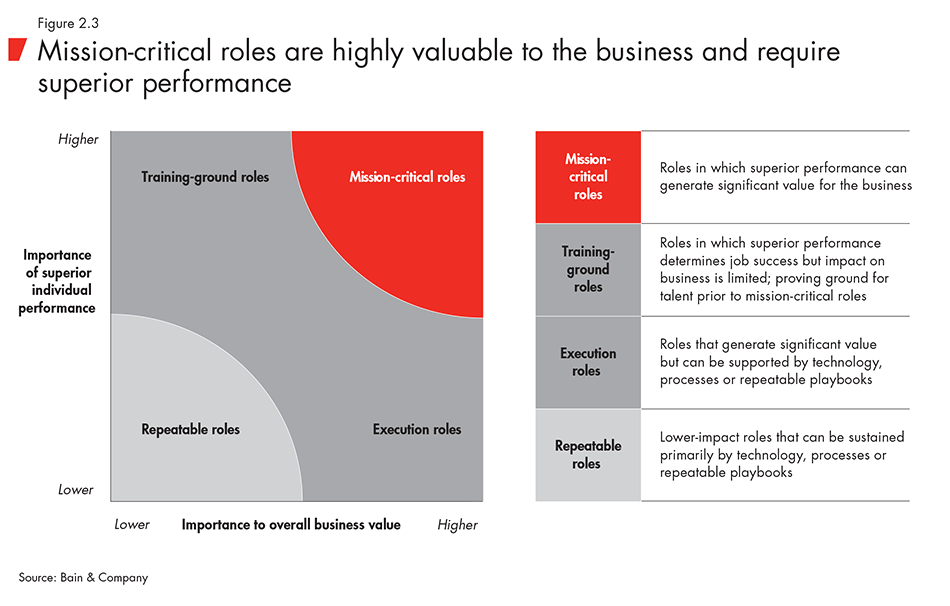
Mission-critical roles tend to involve a high degree of ambiguity and trade-offs. They require quick thinking and the ability to make decisions—both big ones or repeated small ones—that will have a direct impact on the company’s performance against plan. These roles are often customer facing, involving the kind of delicate frontline interactions and negotiations that can make or break a relationship. They also tend to have a multiplier effect, meaning that success in the role begets success in other roles.
As important as these roles are, they can be difficult to identify. Running a major business unit with established relationships and practices might seem like a critical role. But managing a smaller division that is targeting new customers with new offerings may involve more ambiguity and therefore require a higher level of talent. Because these distinctions are hard to draw and sometimes run contrary to the status quo, few companies deploy talent in this way. Most tend to “peanut butter” their A-level players democratically, spreading them evenly across the organization. Top-performing companies are more focused on matching their best people to their biggest jobs. A Bain study found that these leading organizations don’t necessarily have more A-level people, but they are relentless about deploying them in the roles that are critical to the company’s success (see Figure 2.4).
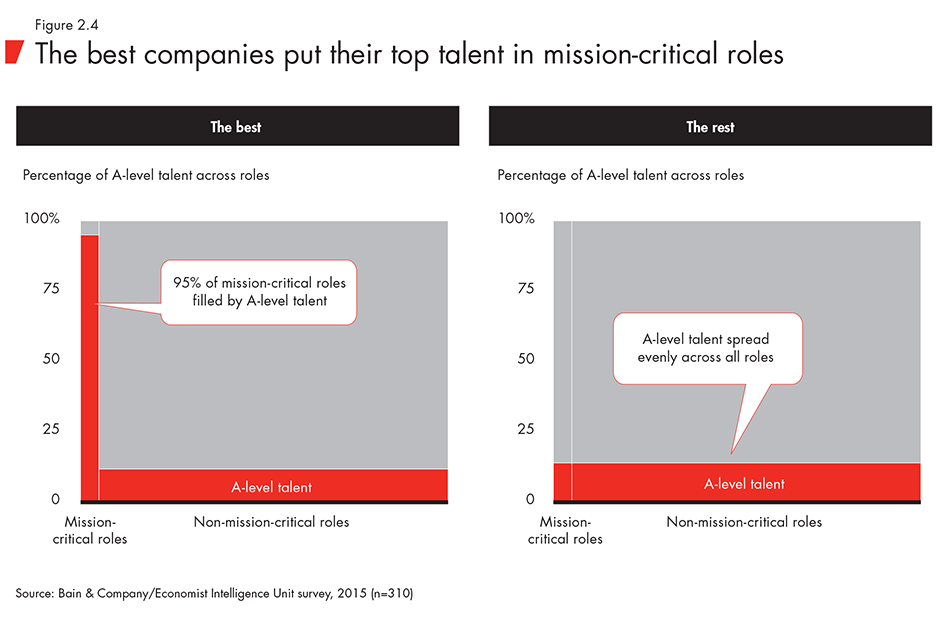
Creating and filling the right roles in the middle of the organization was central to the turnaround of one European consumer products company. After a PE fund bought out the company, it began losing money and breaking debt covenants. Its supply chain was broken, it had a woeful working capital position and it had expanded in numerous directions without strategic rationale.
The fund brought in a new CEO with a track record of success in retail and consumer products, and he quickly undertook a strategic review. The resulting value-creation plan included fixing the supply chain, concentrating on six product categories in which the company had a distinct competitive advantage, expanding its retail and e-commerce presence, and focusing wholesale operations on a set of bigger key accounts. Importantly, it also called for creating a clear decision-making process that relied on rationale and supporting data, not management hunches.
Clarifying the strategy allowed the company to define a set of 20 positions beneath the C-suite that were essential to executing the plan. Some of these, like new heads of supply chain and sourcing, addressed what was broken. Others set the company up for its new strategic push. It added a new head of retail and e-commerce, for instance, as well as someone to ramp up materials engineering and innovation. Filling these roles was more difficult than defining them. The company identified only a couple of candidates internally who had the key mission-critical capabilities. The company eventually found the people it needed by tapping the fund’s extensive network, and the results have positioned it for an impressive exit. After two years, revenue is growing at a compound annual rate of more than 10%, and costs are down, pushing up EBITDA by 150%. The direct-to-consumer model is humming, with all stores and the e-commerce platform (which has doubled in size) showing profits.
Approaches to assessing talent
What we’ve described so far is an approach to linking assessment directly to the value-creation plan in a PE context. But how PE firms assess talent against these parameters is changing rapidly in the digital age. Most often, a firm will outsource the assessment function to a trusted expert that can bring a level of specialization and objectivity to the problem that doesn’t exist in-house.
Assessment methodologies range from a high-touch, bespoke process at one end of the spectrum to a fully standardized and automated process at the other. The high-touch approach recognizes that not all behavior can be measured. It often uses scorecards as a guide, but relies much more heavily on human judgment to uncover what won’t come out in a questionnaire. A data-driven, empirical approach removes human bias and can be highly predictive of success in roles. Automated approaches also scale easily, making them appropriate for large-scale hiring or reshuffling across an organization. A broad universe of companies is pushing assessment methodology into the future. It includes long-established, wide-ranging experts such as RHR International and PE-centric firms like ghSMART and Green Peak. Search firms are also in the game, as are a number of smaller insurgents.
One of those is Chemistry Group, a self-styled “people consultancy” based in London that uses data and analytics to help firms more accurately predict how well current leaders and future recruits will deliver against an investment thesis, even when that thesis differs substantially from what came before. The firm has developed a fully automated process (removing the need for interviews) that evaluates people according to a clear definition of “what great looks like,” which has been tailored carefully to the company’s objectives. Chemistry’s methodology assesses people based on five criteria. They range from hardwired traits like intellect, personality and motivations to factors that are more malleable (and therefore manageable), like experience and behaviors. The “what great looks like” profile is first validated against relevant benchmarks of high performers in similar contexts and then used to evaluate individuals through a set of online tools.
Another assessment firm, London-based Sinequanon, uses high-powered analytics to generate what it calls a behavioral signature based on a company’s specific strategic objectives. Identifying gaps and opportunities in the existing organization according to that profile, it then makes specific coaching recommendations designed to help promising employees close the gaps.
Choosing the right assessment approach isn’t an either-or proposition. High-touch and automated assessments can each add value when defining needs and evaluating talent. Forming the broadest picture of each candidate’s aptitude and potential frequently requires combining quantitative assessment techniques with behavioral interviews, using the former to inform and focus the latter. Still, neither eliminates the need for reference checks to validate assessment findings and lower the risk of a mis-hire. Any approach also depends first on a PE firm’s ability to define the right mission for the portfolio company early on and effectively spell out what roles and talent the organization will need to get there. The mandate is best expressed as a question: Do we have the right talent in the right roles to accomplish our mission over the holding period?
Setting people up for success
Getting all this right requires continuous refinement. As the mission evolves and the balance shifts between quick-hit priorities and longer-term goals, staffing and assessment priorities will pivot as well.
Regular check-ins at a portfolio company are important to ensure that the right team is in place and performing well. It is equally critical to create fast feedback loops between the fund sponsors and the board on one side and the CEO and head of HR on the other. Doing so allows everyone to systematically understand what is going well and what needs improvement, so they can work in partnership to make the necessary changes. Active and frequent communication is a must. There should be no surprises.
It’s also important to broaden the firm’s overall assessment capability by capturing and sharing what deal teams are learning about talent in each portfolio company. This involves developing a continuous learning platform, through which the firm gathers data on people and roles, stores it in a live archive and analyzes it strategically to make better talent decisions across the portfolio.
At both the company and the firm level, the process is dynamic and dependent on continuous, broad-based learning. There is one constant, though: Top firms recognize that their best chance of success is to be thoughtful and decisive about deploying talent that is fit for purpose and ready to execute, at all levels of the organization.
• • •
Commercial excellence: Accelerating organic revenue growth
GPs have historically leaned heavily on cost-cutting strategies to underwrite future value projections and square their deal models. Or they’ve assumed that economic growth and other sources of market beta would be strong enough to propel multiples forward. Today’s macro and competitive conditions, however, challenge either approach. In most markets, slowing economic growth or the outright threat of recession suggests that multiples are more likely to retreat from current record highs than to expand even further. At the same time, the most obvious cost-cutting opportunities are typically baked into inflated asset prices or have already been captured by a previous PE owner.
What’s typically not baked into the price is the ability to deliver profitable organic growth—and to do it quickly. That involves focusing value-creation efforts on the top line and developing commercial excellence capabilities to help portfolio companies sharpen how they approach their chosen markets. Boosting revenues, especially in the face of economic headwinds, is unquestionably harder than improving a company’s cost structure, because it often poses complex questions about which products to offer, how to price them effectively and how to optimize the sales effort. But accelerated top-line growth has the most powerful impact on exit multiples, which means that spotting growth opportunities early can help GPs bid for companies more confidently, generate more value post-acquisition and exit more easily.
Finding a route to growth
An example helps illustrate what a winning growth-oriented strategy looks like. In 2014, when Swedish private equity firm EQT turned its sights on Bureau van Dijk (BvD), a global information services provider headquartered in Amsterdam, BvD had spent the prior decade under the ownership of three separate PE firms. The previous owners had expanded into untapped markets by taking advantage of a strong wave of demand for financial database products like BvD’s trove of information on 200 million companies. They had also lifted EBITDA margins significantly. Given these improvements, it wasn’t immediately obvious what else could be done to create meaningful new value in a short time frame.
EQT, however, saw ample opportunity to improve the company’s commercial organization. Shortly after the acquisition, EQT and the senior management team embarked on a commercial acceleration program managed by a newly appointed global head of sales. The leadership team immediately reworked the customer segmentation model to reflect a detailed analysis of which clients offered the most value globally. It also surveyed customers to find out what really mattered to them and how to maximize value over the life of the relationship. This research guided efforts to prioritize customer groups and devise a tiered sales, service and pricing model to ensure that the organization spent significantly more time and resources on accounts with the most potential.
Next, leadership turned to how the organization approached customers. It aligned the sales team to the new key account structure, allowing the company to deploy salespeople with specific subject-matter expertise and other specialized skills where they were needed most. Based on a bottom-up review of what was working best, it also created consistent marketing strategies suited to the different account categories and developed a new account planning template to focus the entire team on the same winning tactics. Paying careful attention to how much buy-in this new system was generating, the leaders revamped the sales organization to better fit the new go-to-market approach and created a more attractive career path for junior team members. BvD also instituted an employee Net Promoter ® program to measure loyalty and satisfaction among those the company was counting on most to carry out the new strategy.
The results speak for themselves: BvD’s revenues grew at 10% compounded annually from 2014 to 2016, while the EBITDA margin stayed above 50%. By 2017, those results caught the attention of Moody’s Corp., a strategic buyer that saw huge value in BvD’s data business. Moody’s ended up paying €3 billion for the company, with plans to expand its platform into the US and Asia. The successful exit handed EQT an outperforming return on a company it had owned for less than three years.
Hard work, big payoff
Creating value by actively managing for top-line growth works because it lifts profit along with revenue. That generates impressive momentum, making it easier to exit at a high multiple. Our experience suggests that nearly every company can improve both the top and bottom lines by serving customers with a simplified business model that reduces time to market. In a business-to-business (B2B) setting, we typically see a 10% to 20% top-line acceleration, and a 10% to 15% EBITDA uptick, when companies target multiple commercial capabilities, and even bigger benefits when they infuse digital. Our research also demonstrates that median return on investment is 20% to 30% higher when companies use a commercial acceleration program vs. simply improving costs (see Figure 2.5)
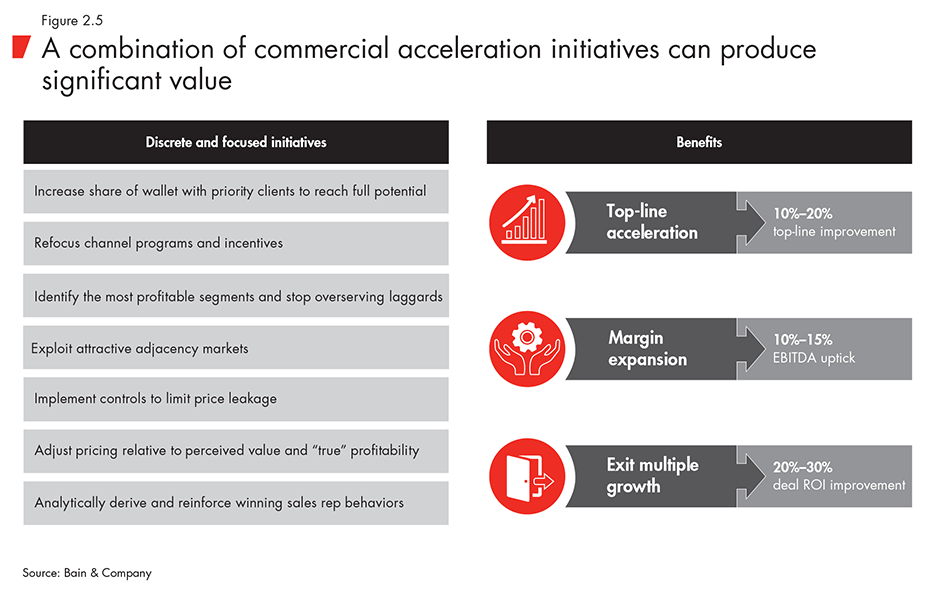
Innumerable factors affect revenue growth, from the strength of the company’s overall vision to the most basic frontline interactions. The sheer complexity of the issue is one reason PE firms have tended not to focus much on the go-to-market model. There is often a perception that commercial acceleration is more art than science and that targeting these capabilities would take too long, be too risky, and require a deep change to culture and mindsets. By contrast, cost reduction is more straightforward and easily measured—you know what you’re starting with, and you know where you’ll end up if you execute a few tried-and-true efficiency strategies.
But firms that have built muscle around the ability to spot deficiencies in a company’s commercial operation find that it opens opportunities that might have been foreclosed to them previously. That’s because many companies—especially in the B2B realm—have yet to reach full potential when it comes to turning an adequate commercial organization into an excellent one. In our research, around 60% of all companies say they haven’t done a good job of focusing their value proposition on their most critical target accounts. Few companies invest in the kind of pricing capabilities that eliminate lost revenue and maximize EBITDA margins. Fewer still regularly zero-base their sales capacity and coverage to ensure that the company has ample resources aligned to the most valuable opportunities.
What’s clear is that vulnerabilities like these are dangerous at a time when digital innovation is revolutionizing how companies identify, understand and serve customers. New entrants and the most agile incumbents are rapidly exploiting technologies like customer and pricing analytics to transform their commercial capabilities. Big Data, for instance, has dramatically improved the precision of market and customer segmentation efforts as firms tap into large streams of transactions, CRM data, social media activity and other windows on customer behavior. For PE firms making investment decisions, this sea-change moment is both perilous and filled with opportunity. Underestimating a company’s exposure to disruption in these areas can be a major pitfall. But diagnosing opportunities to rebuild and modernize commercial capabilities can produce step changes in top- and bottom-line performance, allowing companies to open more markets, generate more sales and do so more efficiently.
Breaking down the challenge
While solving these problems within an average holding period can appear daunting, the most effective firms break down the challenge into the elements of commercial excellence they can address quickly. Every company, of course, presents its own tableau of strengths and weaknesses. Deciding which problems to tackle first is often critical; firms need to get out of the gate quickly with a set of initiatives that will address the issues that really matter. An effective way to begin thinking about how to orchestrate change is to sort target companies by two factors: the complexity of the sales process and whether they have a direct or indirect model (see Figure 2.6). Often that will help determine the optimal starting point for a commercial transformation.
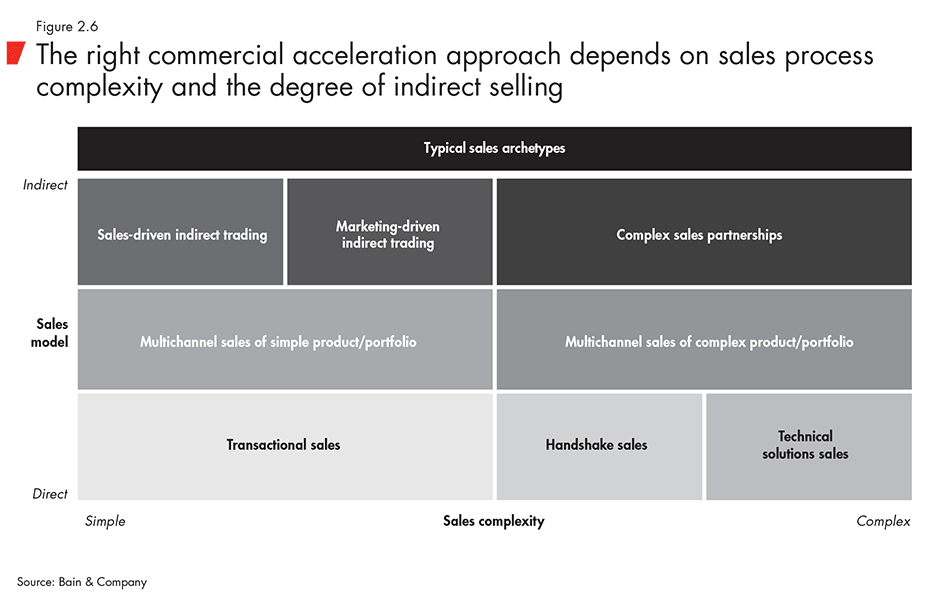
Some commodity companies, for instance, have a direct salesforce and relatively simple transactions. They often suffer from traditional pricing models that don’t capture the upside of value-added products and services. For larger, more complex companies, where the sales cycle may stretch to years and involve a web of products and sales channels, the pricing issues typically entail optimizing prices across channels or reining in non-standard discounts.
Top-performing firms train themselves to narrow their focus in this way because it accelerates efforts to find the right solutions. Take customer segmentation: There are hundreds, if not thousands, of vendors vying to supply companies with analytics tools and solutions that will slice and dice data into meaningful segmentation information. Top-tier firms not only quickly zoom in on the main issues a target company faces, but they’ve built relationships that allow them to understand which tools to apply to which problems, and how to make them work to help create value. As we’ll discuss more deeply later in this section, digital isn’t an end in itself and doesn’t change the fundamentals of PE investing. But the availability of analytics and other tools does allow funds to gain a much better understanding of a target company’s commercial capabilities and identify new opportunities to create value.
Improving due diligence
Because it often takes one or two years for commercial acceleration efforts to bear fruit, the most effective PE funds start early—typically in due diligence—so they can launch a full set of initiatives right away. The firms most adept at sorting through these issues have developed a diagnostic capability that can be used repeatedly in the due diligence process to evaluate upside. That diagnostic then suggests which initiatives the company will need to launch to reach its new aspiration and which tools or technologies it should apply to accelerate results. This kind of clarity provides a valuable post-acquisition jump start.
When one large PE fund began its due diligence on a software company in Latin America, for instance, the issue wasn’t so much about generating new growth as making sure that the company’s commercial organization could sustain its healthy growth rate into the future. Diligence confirmed three main points. First, the churn rate among the company’s customers was higher than the competition’s, raising a red flag. But the company also had the right capabilities in place to bring the rate down to a more comfortable level. Second, while global entrants could conceivably target the company’s core market, the threat was minimal since it was clear foreign players couldn’t deliver competitive prices without investing significantly in building a local presence. Finally, research showed that the company wasn’t penetrating markets as effectively as it might, presenting an enticing and unexpected opportunity. Surveys revealed that many potential customers simply were unaware of the company or its products, something that could be addressed with stronger marketing and other go-to-market strategies. Based on this intelligence, the firm ultimately won the deal. Drawing confident conclusions allowed it to bid aggressively, comfortable that the software company’s current revenue growth was secure and that there was significant upside via a targeted set of initiatives aimed at filling the white space in the market.
Precision post-acquisition
Precision and depth in due diligence provide the best foundation for launching a focused post-acquisition strategy that moves in quick sprints. Making rapid progress depends on breaking the effort into short-term initiatives that the firm can implement in the early months of ownership, even before solidifying the longer-term value-creation strategy. This involves confirming the intelligence gleaned in the diligence phase regarding pricing and salesforce effectiveness. It also means focusing on customer segmentation and bringing a much more rigorous, data-driven approach to assessing the lifetime value of current and potential new accounts.
Based on our experience, commercial excellence programs usually incorporate five main themes (see Figure 2.7).
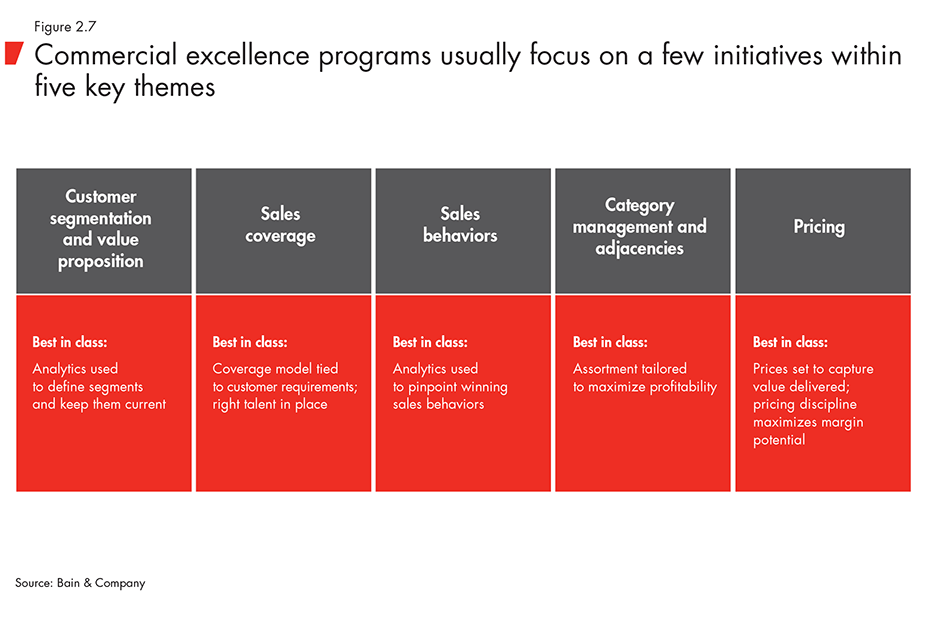
The objective is to create a practical set of prioritized initiatives that can have significant impact and produce early wins. The list depends on each company’s individual circumstances, but the low-hanging fruit often involves aligning the sell/serve model to where the value is, optimizing governance and strategy around pricing, addressing potential cross-selling opportunities or the retention model, and tweaking the portfolio of products or services to better align with customer needs. Longer-term issues—but still addressable in year one—include revisiting the salesforce culture, adjusting compensation and making sure the best people are focused on the biggest jobs.
Spurring new growth was CVC’s objective in 2014 when it acquired majority ownership in Praesidiad (formerly Betafence) from its partner, Gilde Buy Out Partners. The global fencing solutions company had a promising high-security perimeter protection business, which targeted lucrative applications like electricity grid and power infrastructure, oil and gas facilities, large data centers and border installations. CVC knew, however, that putting the company’s base fencing business on another track by accelerating its performance would create the most compelling value story. That business was becoming commoditized, and Praesidiad needed to differentiate itself from low-cost competitors. So CVC’s operations team and the company decided to survey more than 1,000 of its customers in a range of countries to find out how Praesidiad could better serve them.
The surveys indicated that there was ample opportunity to improve product features like gate quality, ease of installation and weight. Customers and distributors also asked for greater order transparency and a more robust online experience, with features like product visualization so they could build systems online. At the same time, the company worked with its sales team to analyze its customer base, looking at how much of the business was run through distributors and how much it sold directly to large customers. Armed with that information, it could determine which route to market was best for which products in which countries, allowing the company to tailor the value proposition and commercial programs for each channel and customer. Step by step, these efforts accelerated the company’s revenue growth and set it up for the next stage of global development. By July 2017, CVC had sold the Belgium-based company to Carlyle, generating a healthy return.
It’s often essential post-acquisition to delineate which aspects of capability building will take place over a period of years and which aspects of those initiatives can be implemented immediately. After San Francisco’s GI Partners used an M&A strategy to build three companies into SoftLayer Technologies, for instance, it formed a commercial acceleration plan based on both short-term and long-term objectives. A new market entrant with a large capital budget was challenging the fast-growing US-based cloud services company. The cloud services sector was also experiencing a change in the pricing paradigm that was causing market confusion. So, after focusing on growth through acquisition for several years, GI shifted its attention to a set of measures aimed at spurring internal growth.
GI determined that SoftLayer would benefit from building out its product management, marketing and outbound sales organizations. The company lacked a robust product roadmap and needed to develop teams capable of opening new markets and attracting the interest of new types of enterprise customers. Building some of those capabilities would take several years; others could be developed more quickly. The answer was to launch a series of initiatives aimed at producing immediate results, before turning to the longer-term opportunities. The company set up a sales outreach program targeting its top 2,000 customers and launched marketing campaigns around cloud trials to produce incremental revenue gains. It also focused on a large, coordinated product launch designed to generate excitement.
Within the year, SoftLayer’s outbound sales and marketing efforts had developed new and much stronger relationships with several hundred of its customers, opening the door to new sales and reducing churn. The marketing promotions worked to convert trial customers into paying ones. Top-line acceleration created momentum behind longer-term capability-building initiatives. With the company showing attractive growth in 2013, GI sold it to IBM (which eventually dubbed it IBM Cloud), generating a solid return on its initial investment.
Delivering results like these consistently will challenge PE firms that have relied historically on efficiency measures and market beta to drive multiple expansion. But with multiples already dancing at historic highs, the ability to ignite top-line growth is likely to separate top-tier performers from the rest of the pack in coming years. The first step in developing the right capabilities is to recognize that creating value via top-line expansion isn’t as hard as it’s made out to be. By focusing on the nuts and bolts of commercial excellence, firms can develop relatively straightforward, repeatable strategies for diagnosing problems in diligence and quickly tackling them upon securing ownership, opening up a new set of viable targets among the large number of companies that underperform commercially.
• • •
Digital savvy: Seizing opportunity amid rapid change
Not long after Philips spun off its $6.2 billion specialty chip business to a consortium of PE firms in 2006, the global financial crisis hit with a vengeance. As the new NXP Semiconductors began to bleed red ink, a promising deal turned into a harrowing one. Not only had the bottom fallen out on the economy, but the company was adrift strategically. For an ownership group led by KKR, Silver Lake, Bain Capital, AlpInvest and Apax Partners, rescuing it meant navigating one of technology’s most fiercely competitive and highly volatile sectors.
Despite a high degree of industry uncertainty, however, the new owners treated NXP as a classic turnaround story. They believed the company’s real challenges were internal, not external. Yes, it played in a highly volatile set of markets, which were being roiled by digital innovation. But it was losing money because it lacked a strategic compass, suffered from massive organizational complexity and had an uncompetitive cost structure—the same sorts of issues that can drag down a promising company in any industry.
Within four years, NXP had transformed itself from a corporate stepchild into a strong global competitor. Through a series of key divestitures and acquisitions, its new owners focused strategy on the company’s biggest strength: chips that enable secure connections in applications like Apple Pay, factory automation and advanced automotive electronics, including autonomous vehicle technology. New management cut costs, created a “fab-light” manufacturing platform and sped up introduction of new products. The company also revamped its go-to-market strategy to focus on its best markets and customers, resulting in a successful expansion into the Chinese automotive sector. With margins on the upswing, the consortium took the company public in 2010, the start of an eightfold rise in the stock price over the next five years that allowed the firms to gradually make their exit (see Figure 2.8).

At a time when digital innovation is disrupting markets and transforming businesses with alarming speed, a story like this one can be grounding. It demonstrates that capturing value in a digital context relies more on the standard PE value proposition than any fundamental change in the way a firm approaches investments. What’s clearly different in a digital world is the unprecedented pace of change and the increased risk of getting blindsided. But it cuts both ways. The explosion of data, analytics and connectivity has dramatically enhanced funds’ ability to assess companies in due diligence and to improve their performance during the holding period. As markets rapidly transform, funds can find as many opportunities as risks if they have developed the ability to handicap change better than the competition.
Digital technology has transformed the landscape in ways few could have anticipated even five short years ago. Yet for PE funds, the investment lens—“How can I increase cash flow over the next three to five years, and how can I boost the company’s franchise value at exit?”—is still the best one. The challenge has become learning how to blend investment savvy and analytics into a methodical, fact-based approach that sheds light on how profits are being reapportioned in a specific industry and how ready a target company is for the change. This demands a fresh set of questions when evaluating assets: Is digital expanding or reducing the profit pool for a target company’s industry? How does the impact vary by industry segment? Is the target in fast- or slow-moving water? What is it doing, or what could it do, to seize the opportunities and mitigate the risks? What is the net effect on deal return?
Today forward, future back
The uncertainty can be paralyzing at times, but the truth is that most companies have a reasonably good idea about where their industries are headed in the next 10 years or so. While every industry and subsector has its own dynamics when it comes to digital penetration, the broad outlines of the change are knowable and measurable. Retailers know that simple e-commerce is being replaced by increasingly sophisticated omnichannel offerings that blur the line between online and physical experiences. Auto suppliers know that autonomous and electric vehicles will change how they must approach the market in the not-so-distant future.
For PE investors, the more pressing challenge is charting the right course forward amid turbulence and rapid change. Even when you have a pretty good sense of where an industry is heading, it’s rarely easy to decide which practical steps to take right now, to both improve cash flow and set the company up for the most rewarding exit. The problem for most target companies is not a lack of ideas for how to move forward in a digital world, but too many. Private equity’s opportunity is to narrow the aperture based on an empirical analysis of industry-specific impacts. Investors can bring a pragmatic vision of how to generate both short-term performance and progress toward a longer-term horizon. Even for companies facing a threat the size of Amazon.com, an in-depth, pragmatic assessment of competitive strengths and weaknesses can lead to a clear path forward (see “Spotlight on Amazon: Coping with the Amazon factor in due diligence” on page 62).
In our view, the most practical approach is to look at each target company’s unique set of circumstances from two perspectives: today forward and future back (see Figure 2.9). The first assesses how digital is already affecting the profit pool of that company’s particular subsector and what the company needs to do to respond. That involves diagnosing the company’s strengths or weaknesses and then isolating the set of initiatives that will produce the biggest step change in performance over the next three to five years. Future back comes from the opposite direction. It entails envisioning as clearly as possible how technology will transform the profit pool over the longer term and then extrapolating backward to prioritize the steps a company can take now to best position itself for that future. When it comes time to exit, in other words, will this company have a longer-term story to tell about how it will thrive as the industry’s future continues to unfold?
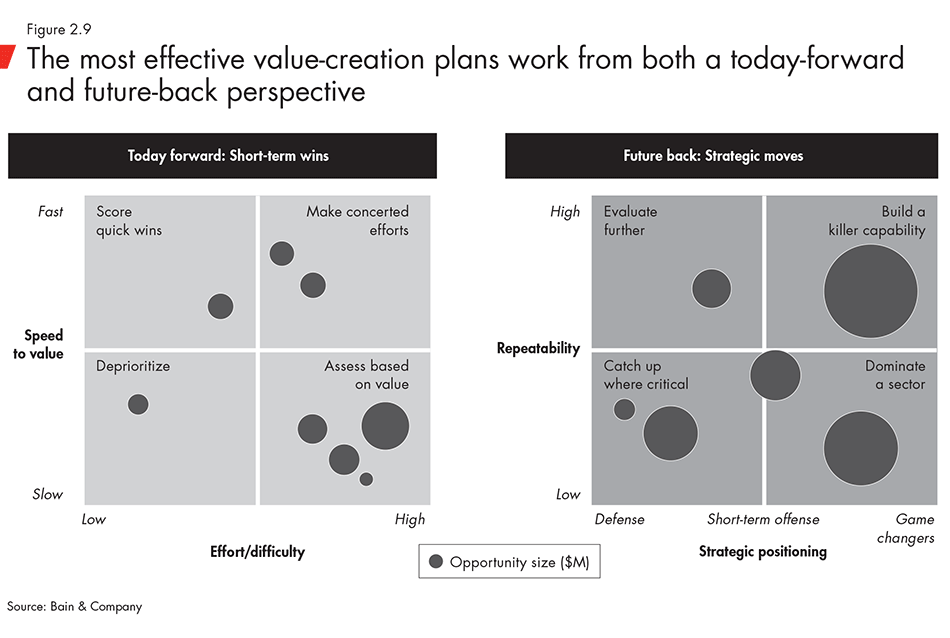
For one global PE firm, the combination of today-forward and future-back thinking led to substantial gains early in its ownership of a software firm. The company, an incumbent facing fierce competition from both established players and new insurgents, had an opportunity to improve performance. It had a deep installed base and a strong brand, but it had lost momentum and needed a more aggressive strategy in terms of products, digital marketing and M&A.
A big part of its go-to-market strategy, for instance, was offering new customers a free trial, after which the company would try to convert them to a subscription service. Static and feature-based messaging, however, had resulted in a low conversion rate of customers who had accepted trial offers. The company had recently adopted new dynamic messaging technology that allowed it to target specific online customers with specific messages at specific times. But real improvement in the conversion rate didn’t come until the company married the tools with a new, more agile way of working.
Using a test-and-learn methodology, cross-functional teams identified and focused on the key “moments of truth” in the trial cycle. They broke down how different kinds of customers reacted to conversion messaging in those moments. They then ran test after test to determine which combinations of messaging and offers would win over the most customers. The company also conducted a thorough analysis of which website design changes would generate the greatest return on investment, and it mined customer data to see which customers weren’t converting and why. Over a period of months, a continuous cycle of test, learn, adapt and test again produced a set of winning initiatives that drove a double-digit percentage increase in conversions (see Figure 2.10).
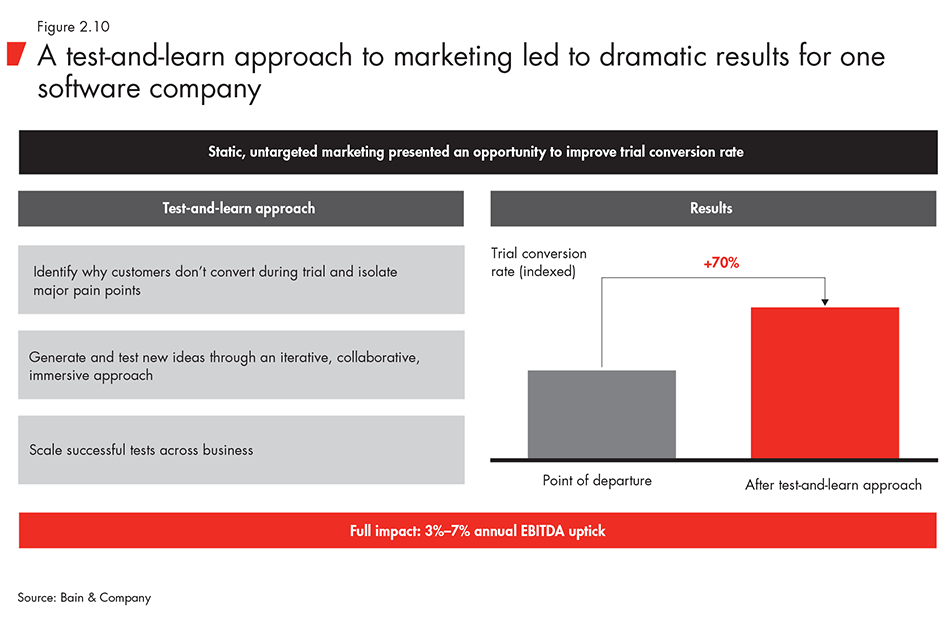
From a today-forward standpoint, that was a major win. But it was also compatible with a broader future-back perspective. Given the pace of change in the company’s various businesses, speed and agility in reacting to market shifts were the most important aspects of becoming future-proof. If the company could transfer the agile approach it used to improve marketing and the customer experience more broadly, it would recharge the entire business’s metabolism. Speed itself would become a competitive weapon.
Striking the right balance in due diligence
The balance of today-forward and future-back thinking will be different for every company as it weighs how to invest for a digital future. Because PE investors are generally focused on creating value over the next three to five years, however, their primary emphasis during both due diligence and ownership is today forward—that is, what can they do now to generate EBITDA and improve top-line growth? The combination of a short time horizon and high levels of leverage means the approach has to be grounded in what’s possible during ownership. While there might be a plausible “march through the valley of death” to transform a company for the future, a PE fund typically isn’t in a position to take that on.
That said, investors can profit from the future-back perspective for two very practical reasons. First, a thorough, fact-based analysis of what’s knowable about the future is the best defense against paying too much for an asset or being blindsided later. Considering the extraordinary pace of change in many industries, investors need assurance that an asset is secure for at least the next two PE cycles. Second, a firm grasp of what’s coming provides the foundation for the most effective value-creation plan. It gives direction to the short-term initiatives and helps the fund build the most compelling exit story.
Striking the right balance in diligence is rarely straightforward, but it is critical to begin the analysis early to determine risks and exposures. When one PE firm recently considered investing in a European retailer of vitamins and health supplements, the company’s real potential became clear only after a thorough analysis of current pricing patterns. Initially, the fund’s leadership was excited about the target company. It was well positioned in a hot sector—health and sports nutrition—and had developed impressive e-commerce capabilities that gave it a leading share of online traffic. E-commerce penetration in the subsector, however, had unleashed a wave of aggressive competition, suggesting that the firm focus its due diligence on assessing how resilient the company’s position really was.
An initial inquiry showed that revenue had softened over the previous few months—not hugely, but enough to prompt further analysis. Using digital tools like the Wayback Machine to look at competitive pricing over time and SimilarWeb to link traffic shifts to fleeting price changes, the fund could see that strategic price-cutting was shifting traffic to lower-cost platforms. The company had already lost 5 percentage points of traffic share in a matter of months, raising a bright-red flag. The question was whether it had any of the attributes that companies in other sectors have used to fend off e-commerce price competition—things like a strong brand, premium positioning, a unique assortment, additional services and advice, or a vibrant online community. Because the company wasn’t particularly well differentiated in any of those areas, the fund decided to pass on the investment. Data since then has validated the decision: About five quarters after the due diligence ended, the company had lost another 10 percentage points of traffic share.
Analytical precision, of course, can also turn up opportunities. When one PE firm targeted a US-based B2B equipment distributor recently, it saw that the company faced growing competition from online specialists. Amazon, which had been making a strong push in the B2B sector, was also a possible threat. Still, the company was growing nicely, with steady demand and attractive market dynamics. To find out what e-commerce expansion in the sector might mean for the company’s profit growth, the fund conducted a three-part analysis (see Figure 2.11).
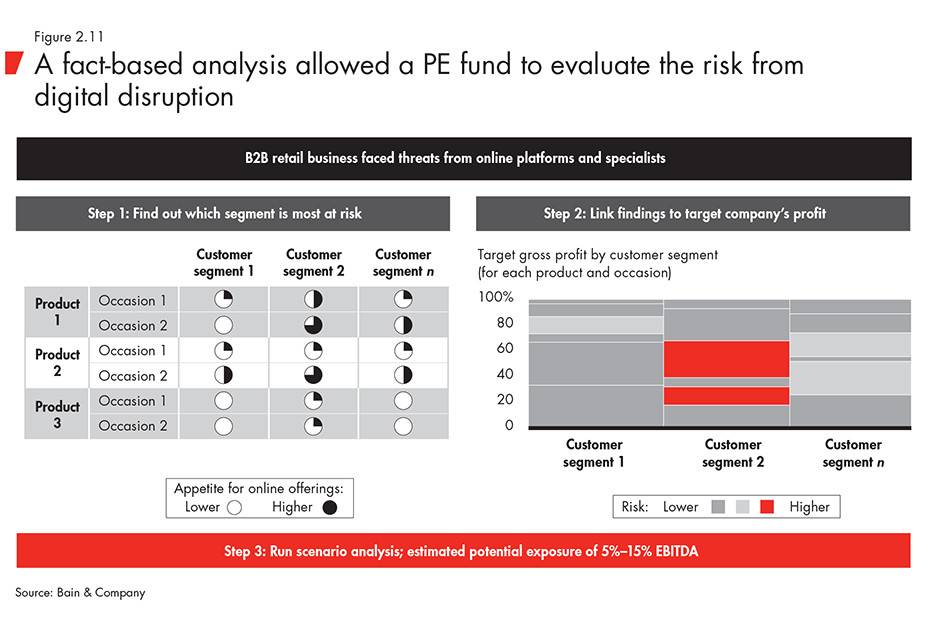
First, it surveyed a large number of customers to find out which type of account was most likely to shift purchases online and which products might be involved. The fund then matched these findings to internal data to see what proportion of the target’s gross profit was at risk. Finally, it did an extensive competitive analysis to gauge how much product overlap there was with online retailers and how vulnerable the company’s at-risk products were, based on factors like price and service offerings. The data showed that few large accounts would shop online for heavy equipment, especially new equipment. Smaller accounts, meanwhile, were already ordering replacement gear online. The potential exposure added up to between 5% and 15% of EBITDA—not an insubstantial number, but low enough to get comfortable with, particularly given the ample cost-cutting opportunities the fund had already turned up. The deal team also saw that the company had time to develop its own e-commerce capabilities, providing potential upside. In the end, the analysis allowed the fund to adjust its price to a known level of risk, and it ultimately prevailed in bidding.
Step by step during the holding period
The most effective value-creation plans marry a today-forward orientation with a future-back perspective. They identify a clear point on the horizon and aim the company in that direction by laying out a set of practical initiatives—usually digitally enabled—that can create meaningful progress in the short term. These are stepping-stones, concrete measures that generate EBITDA now while bringing the company closer to its objective over the next couple of years.
They tend to lead along eight pathways (see Figure 2.12). The first four focus on what the company does: customer and channel engagement, operations, products and services, and new business models. The next four pathways describe how the company delivers: platforms and partners, data and analytics, IT, and operating model and people. The destination may shift—sometimes you don’t see step 2 until you’ve taken step 1. But ultimately, these steps should begin to create a new company narrative, ensuring that the business is pointed in the right direction at exit.
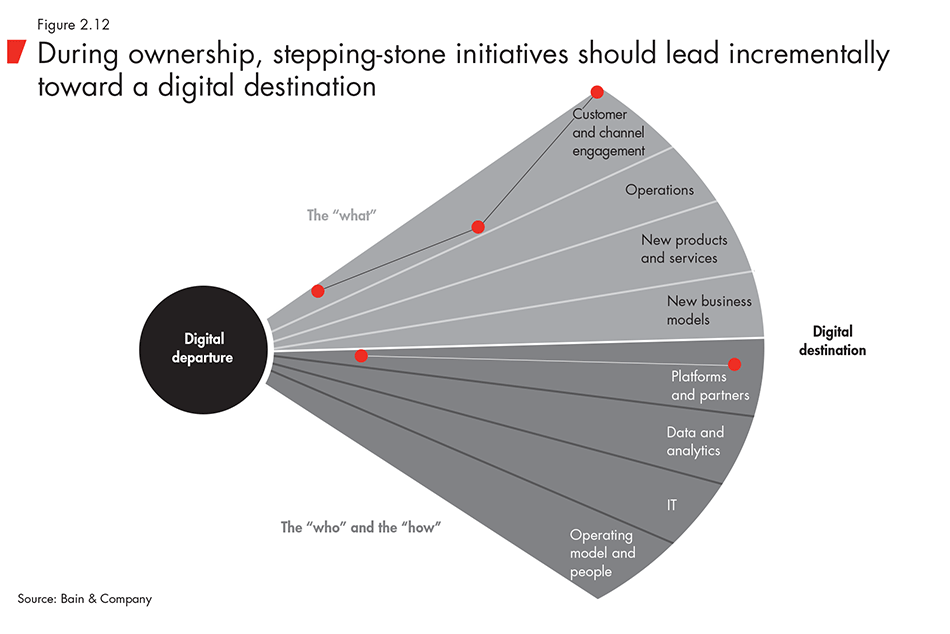
The journey for Sunrise Communications, a leading Swiss telecom carrier, began with simply getting its house in order. When CVC bought a majority stake in Sunrise in October 2010, deteriorating network quality and inefficient processes were making it difficult to keep up in an increasingly competitive telecom market. Sunrise and CVC’s operations team started to rebuild many of those processes and redesigned customer journeys, seeing big jumps in customer and employee satisfaction scores. That stabilized the situation, allowing the company to focus on how it could use digital tools and processes to not only meet customer expectations but exceed them.
At the center of that effort was the “customer experience factory,” an approach powered by the idea that digital innovation in the customer experience is more about management science than applying the latest digital tool. Speed to market with the best solutions depends on creating agile, cross-functional teams that can assemble the right technologies to match the specific challenge and then fit them to the company’s IT infrastructure. The factory metaphor is apt: The inputs at one end are broken customer experiences. The factory floor is where teams immerse themselves in the problem, with a specific focus on the worst customer pain points. Adopting a sprint style, they create prototypes of improved solutions and put them through an iterative process of test, learn and adapt. The outputs are new sets of processes and solutions designed to transform how customers view the company.
Sunrise’s approach to handling delinquent bills provides a good example of how the customer experience factory works. The company’s original dunning process made everybody miserable. Delinquent customers, no matter how loyal over time, would be cut off unceremoniously after receiving a short text message. Worse, the company gave them no way to pay the bill and unblock the account automatically. This made for angry people flooding the customer service lines and resulted in high levels of lost revenue. It was the kind of customer experience that gives telephone companies a bad name.
After putting the broken process through the customer experience factory, however, the company developed an entirely new, digitally enabled solution. By tapping a deep well of customer data, Sunrise could see which customers were most likely to overspend and send them an advance warning—a friendly nudge via text message detailing the amount due and notifying them that they were at risk of a service blockage. The company then provided a way to unblock service automatically through a variety of payment options. By addressing specific pain points with well-tested solutions, the company changed the economics of dunning. It improved the customer experience and reduced the number of blocked customers by 35%, while cutting bad debt by half. That and a series of other stepping-stone customer initiatives, including a full revamp of the website, improved the company’s overall results. In February 2015, CVC raised $2.2 billion by taking Sunrise public in Switzerland’s largest IPO since 2006. The firm progressively exited the business between 2015 and 2016, producing a high return on its initial investment.
Defining the stepping-stone initiatives that will have the highest impact during the holding period isn’t about being dogmatically digital. Success flows from matching digital to strategy. Too many companies rush toward new tools without a clear reason why. They’re certain Big Data and analytics can help them understand their customers better. They want to bring more transparency to their supply chain or tap smart machines to improve efficiency. But unless technology serves specific objectives, it’s merely an expensive set of buzzwords.
Mobile is one of those words, and it can mean almost anything. For two PE-owned companies, it was an essential component of value creation, but in two very different ways.
- The first company, a national restaurant chain, had no meaningful customer data, relying instead on the blunt instrument of TV advertising to bring in customers. The first stepping-stone was a traditional analysis of its media spending to fine-tune its impact and free up cash for the kind of mobile and social marketing that would attract younger diners. Partnering with a digital marketing agency specializing in test-and-learn techniques, the company pursued a second stepping-stone: rapid prototyping of different digital media ideas to see which had the biggest impact on store traffic. The company had been spending ineffectively on Google keywords, for instance, and a test-and-learn approach helped it to isolate the most effective mix. It tested micro-tactics like social media ad placements to drive local traffic at critical decision-making times. These strategies lacked the scope of a TV spot, but they added up to real results over time, generating a 40% increase in ROI through the digital channel. The money saved helped finance a critical (and simultaneous) third stepping-stone: building an app-based loyalty program (including a substantial investment in the back-end integration) that began to collect the kind of customer data the company needed to sharpen all of its marketing efforts.
- For the second company, a retailer, the first stepping-stones involved revamping its website and digital marketing approach. Initial strategies centered on boosting online traffic and conversion through better use of keywords and by honing the company’s online video campaigns, leading to a 30% profit increase within months. That bought time to focus on solutions for creating a more vibrant in-store omnichannel experience. The new owners rapidly piloted a new mobile app for the sales associates that displayed the retailer’s entire product catalog, allowing them to show customers high-traffic, but hard-to-stock, categories. It also allowed users to make purchases directly from the retailer’s Shop the Look Instagram feed and integrated with the Square payments app to quickly process transactions, linking to the retailer’s loyalty program. By connecting the right “plumbing” in this way, the tablet-based system raised the bar on the in-store experience. The pilot led to an incremental 5% increase in same-store sales, justifying a broader rollout.
Diagnosing digital change across the portfolio
These individual successes suggest that every PE fund should be systematically probing its portfolio to find opportunities to exploit digital technology and innovation. Performing a digital diagnostic across the portfolio can be an effective way to identify which company-specific and firm-wide initiatives will produce the most value in the shortest time frame. It helps firms set priorities and accelerate change.
An effective portfolio scan begins by conducting sector scans to identify the most important sources of digital disruption facing portfolio companies. That helps the firm assess how ready they are to compete in the emerging new normal. We find it useful to score sectors on a digital disruption index, which tracks how digital is affecting key aspects of doing business in that industry: products and services, customer and channel engagement, operations and new business models (see Figure 2.13). It’s then possible to rank companies according to how thoroughly they’ve kept pace with these changes and to what degree they are deploying technology across the value chain.
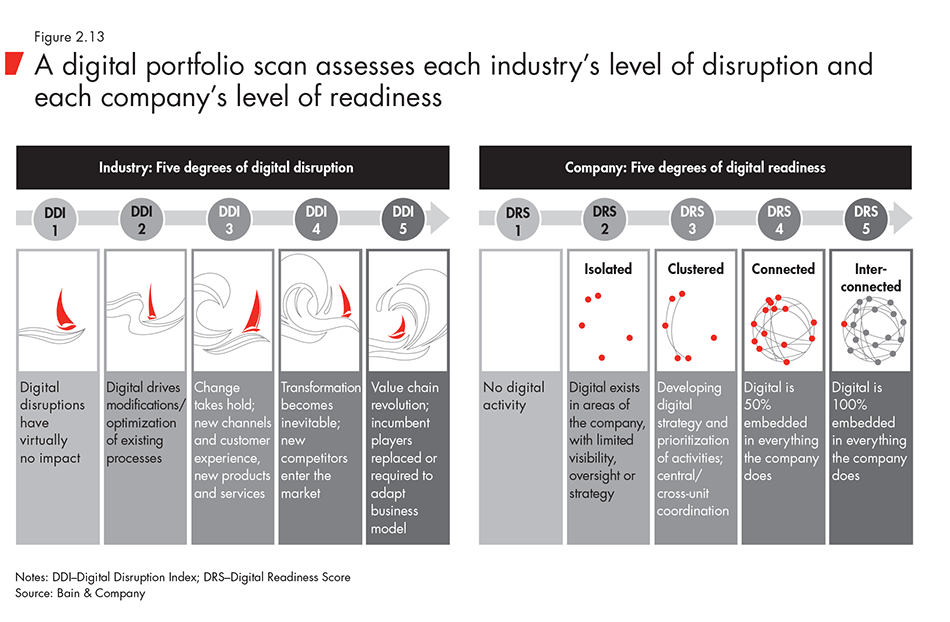
The most effective scans directly engage the leadership of portfolio companies, encouraging them to contribute ground-level insights and feedback on the industry assessments. Company interviews are also critical to determine how much digital technology has seeped into the organization’s DNA. The assessment looks at the company’s digital systems and infrastructure, its technology stack, its fluency in analytics and the management systems in place to support a digital transformation. It’s designed to measure the quality of activity, not the quantity. Most companies are overrun with digital initiatives; fewer have developed capabilities to sort and prioritize them based on potential impact and strength of the use case.
Using these assessments, funds can benchmark portfolio companies against their competition and begin to assign value to initiatives that can close readiness gaps or exploit strengths. The process also identifies sources of weakness or strength across the portfolio, such as opportunities to create a digital marketing center of excellence or effective ways to share best practices in supply chain transparency. The objective is to shine a light on the two or three initiatives that deserve the firm’s most immediate attention, so firm leadership can marshal the resources to accelerate those projects. Ultimately, the process can be molded into an internal capability that becomes business as usual, allowing the fund to assess industry-specific digital developments on an ongoing basis and create a running inventory of priorities for helping portfolio companies adjust to potential disruption.
Tapping the digital ecosystem
Top-performing PE firms are increasingly building capabilities like these, aimed at accelerating their own digital readiness. But most we talk to view the challenge differently than you might think. While they value technology expertise and digital savvy, few believe that simply hiring in-house digital experts will add up to smarter investment decisions. Today’s expertise may be out of date tomorrow, and no single person can possess the kind of industry-specific knowledge that produces real insight on investments. In our experience, firms are better off building an ecosystem of capabilities and expertise to support the digital needs and analytic ambitions of their portfolio companies. It might include:
- Networks of IT providers, advanced analytics vendors or digital partners, specific to each sector, that can provide a foundation of digital support for portfolio companies
- Centers of excellence within the firm that allow portfolio companies access to proven solutions or best practices in areas like digital marketing or social media
- Connections to outside digital thinkers with expertise in technologies or industries of special importance to the firm, who can provide perspective on digital trends and what they mean for the portfolio companies
- An internal team to orchestrate digital change and program-manage portfolio-wide initiatives, as well as help fund investors understand major technology trends and how they affect various industries represented in the portfolio
Getting ready
Digital technology and innovation are changing many assumptions about business, and PE firms have to understand what these changes mean for target and portfolio companies. But amid all the hype around digital transformation, it’s important to remember that the PE value proposition is already well suited to finding value amid turbulence. As some leading firms have shown, GPs can effectively measure the impact of digital on industries and companies by evolving the same methodical, fact-based approach they bring to all investments—one that makes full use of the digital tools and analytics available to home in on customer behavior and company performance. Top performance in coming years will likely depend on how effectively a firm can understand what’s changing and make investment decisions based on that diagnosis. GPs can start with some key questions to gauge their own readiness:
- How do you embed digital in your deal-generation strategy?
- How do you use digital in due diligence to make better decisions?
- How exposed is your portfolio or a target company to digital disruption?
- Are your portfolio companies ready in terms of digital and analytic sophistication?
- What are the opportunities to create digital value within your investment horizon?
- What quick-win, no-regret moves should you act on immediately?
- What future-back game changers do you expect?
- What digital capabilities should you develop to support the digital and analytic ambitions of your portfolio?
Spotlight on Amazon: Coping with the Amazon factor in due diligence
For investors and corporate leaders in an ever-increasing number of industries, Amazon.com resembles nothing so much as The Blob—the alien antihero in the classic 1958 movie with the tagline “It eats you alive!” Amazon already controls roughly 40% of the US e-commerce market and is on track to own 50% by 2021. That implies that the Seattle-based retail disrupter will capture around 70% of all e-commerce growth over the next five years.
But that’s hardly the end of it. Extending into B2B commerce and distribution, cloud services, media and hardware, the Amazon ecosystem now covers a huge part of the economy. The double-digit monthly percentage growth of its Amazon Business commercial distribution unit provides ample evidence of how hard it is pushing. Whether Amazon’s sprawl presents a threat or an opportunity for a given company depends on the context. For consumer products companies looking for quick online distribution to a mass audience, the Amazon platform might be a game changer. The same could be said for B2B companies looking to build cloud services without having to make noncore investments in server infrastructure. The threats, on the other hand, are obvious. Amazon achieves this growth by offering the world’s largest selection, lowering the cost of goods and fulfillment, and providing a best-in-class customer experience. Add in an incredibly nimble organization, and Amazon seems able to disrupt businesses at will.
What all this means for PE firms is that Amazon has become a factor in the due diligence of almost any target asset across the industrial, consumer and retail sectors. In more and more cases, underwriting future value means, at least in part, assessing the “Amazon factor”—good or bad. Firms need a systematic approach for understanding what Amazon is likely to do in a given sector, product category or business and how a company stacks up against the potential threat or opportunity. The good news is that advanced analytics, combined with deep pools of customer and market data, allows firms to measure impacts and opportunities as never before. But the process begins with some relatively straightforward questions. In the retail sphere, for instance, top firms start with four key inquiries:
Where are the target company’s product categories on the e-commerce penetration curve?
The e-commerce freight train is bearing down on all sectors, but it’s important to distinguish between those that have already felt its full impact and those that are feeling it now. An e-commerce penetration curve shows where a category’s sales growth is coming from (online vs. in store) and where the trend is headed (see Figure 2.14).
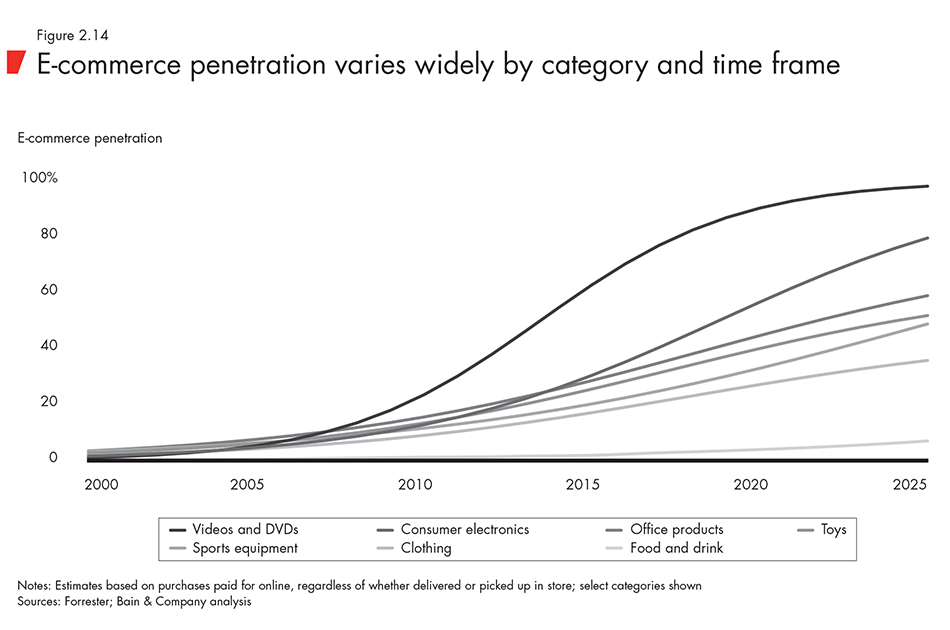
Predicting future penetration takes into account factors like online pricing, customers’ ability to find what they are looking for in stores, and how easy it is to deliver or return goods. The landscape is always shifting, as retailers constantly innovate to lift the constraints on e-commerce adoption and improve their omnichannel experiences. Knowledge of the major players in each category is critical. What investments are they making to shift sales online or increase in-store purchases? How is Amazon likely to play its hand? Amazon CEO Jeff Bezos is known to say, “Your margin is my opportunity.” Considering that the company’s stock price is fueled by growth, big profit pools, especially those with limited online penetration, are most at risk of Amazon investing heavily to win.
While penetration for large categories may be readily known, target companies frequently play in specific subcategories that deviate from the aggregated category curve. Mass beauty and luxury beauty, basic apparel and fashion apparel, pet food and pet toys—each have different penetration curves. For the grocery business, overall e-commerce penetration is projected to rise slightly by 2025, to just 6% to 8%, due to challenging economics and logistics. But online penetration for shelf-stable products, specialty items and household goods should grow to a higher percentage than that, while penetration for fresh and frozen items will likely be lower. Of course, as Amazon absorbs Whole Foods and retailers react, the situation could change in ways that are highly unpredictable and potentially game changing.
Does the target have a compelling assortment at a good value?
Among Amazon’s great strengths is the ability to offer the widest possible assortment at great prices. Factor in free two-day shipping through an Amazon Prime membership, and the advantage can be overwhelming. Whether a target company can compete often depends on whether it can offer customers a unique set of products at a good value. Assessing how the company’s brand and product offering overlap with Amazon’s is critical to understanding how vulnerable its sales are.
The task can be daunting. For any retailer, the number of SKUs can easily run into the many thousands. Matching these one by one against Amazon and other direct competitors can be a massive effort. Amazon offers hundreds of millions of SKUs, so there is bound to be overlap. The challenge in due diligence is to compare items based on an array of data points, such as price, Prime participation, availability of two-day shipping and whether the item is a third-party product fulfilled by Amazon. If the overlap is extensive, the target offers more expensive products than Amazon does, and Amazon competes with features such as Prime or fulfillment services, then the picture doesn’t look good.
That said, even if there is substantial product overlap with Amazon, it isn’t game over. A retailer with a well-curated assortment may still be the customer’s first choice. Consumers of baby products, for example, may opt for a retailer that offers a wide selection of high-quality goods deemed safe, chemical-free and nonallergenic because they trust that retailer’s specialized knowledge and experience. Ultimately, due diligence should identify how well a target company is positioned against Amazon, based on a clear measurement of assortment overlap and the key factors that can mitigate that threat.
Does the target have a differentiated and valued customer experience?
Amazon’s customer experience is hardly flashy, but it clearly delivers on the things that matter most to customers. Bain’s 2017 Advocacy in US Retail study, conducted in collaboration with ROI Consultancy Services, looked at the Net Promoter Score® (NPS®), a measure of customer advocacy and satisfaction, across top retailers (see Figure 2.15).

The study revealed that Amazon has the highest Net Promoter Score among top retailers for many categories, including home products, consumer electronics and sports equipment. Even in women’s clothing, where Amazon has its lowest NPS, it remains among the top 50% of retailers.
Amazon is relentless in its quest for an improved customer experience, and it isn’t shy about exploring a multitude of options to see what sticks. Consider the company’s approach to apparel sales. Amazon knows that brick-and-mortar stores attract customers who like to try things on. So in relatively short order it has tried a wide variety of tactics to replicate this—offering fit reviews, acquiring Shoefitr and testing Prime Wardrobe, to name a few.
Companies can fight back with a more compelling customer experience, as long as it presents a discernible and defensible advantage. The retailers that are having the most success offer services Amazon can’t match—a uniform retailer featuring high-quality tailoring services, for instance, or a retailer offering an omnichannel customer experience that seamlessly blends a full suite of digital features with the advantages of a physical store.
Does the target have a reliable way to drive traffic?
Approximately half of all consumers start their online searches for goods at Amazon. That can be an instant advantage for companies that sell through the online retail giant. For others, it presents a major challenge. Investors need to know where search traffic starts for each category a target company plays in and how the company plans to boost its visibility. Amazon itself is very good at ensuring that its offerings rise to the top of Google searches when it enters a category. But there are highly effective search optimization tools and strategies that companies can use to fight back.
Retailers can also develop an advantage with aggressive strategies to drive people into brick-and-mortar locations. Beauty retailers, for instance, attract foot traffic by offering free consultations and tutorials in person. The key is to analyze traffic holistically to understand how a target generates traffic and whether it will be able to sustain its current flow of customers over time.
The issue of defensibility is at the heart of all four of these questions. If a target company has developed an advantage, how likely is it to persist? Can others (Amazon included) simply replicate it? Context matters a lot. Even if the picture doesn’t look great for a target in the face of Amazon, it might look better than it does for competitors, presenting an opportunity to gain share that others lose.
Diligence case study: Big Box Co.
When a big-box category killer put itself up for sale, the Amazon question loomed large for a PE firm considering a bid. The company had a healthy balance sheet and a strong brand relative to its peers. Amazon hadn’t made a major move in the category yet, but the firm wanted to understand where the target was vulnerable to a more forceful incursion.
Due diligence centered on building a comprehensive model by marrying Big Data analytic techniques with direct consumer research to determine Amazon’s likely impact across 12 product groupings. It measured how defensible the target’s position was and what percentage of its margin was at risk.
After defining a set of six key competitors, including Amazon and several traditional retailers, the firm tapped a river of data from the web, using advanced analytics to determine SKU overlap and pricing gaps by product grouping. The data showed where the target company was the price leader, where it trailed and what percentage of its business fell in each category. Extensive customer surveys and industry interviews provided an in-depth look at what spurred different customer segments to shop online, by product grouping. It also quantified how strong the company’s overall customer experience was relative to competitors, signaling where it was vulnerable and where it had an advantage despite pricing gaps.
This was less rocket science than digitally enhanced heavy lifting to pry open a view on the company’s competitiveness. The next step was measuring its digital readiness using an omnichannel fitness assessment. This tool scored the target company against Amazon and the others across 50 different metrics, from price and selection to search engine relevance and quality of user interface. It determined how well the target was blending digital offerings with its physical-store advantage to attract customers and create a bulwark against rivals. These insights could then be translated into market share assumptions. They also suggested where improvement might yield upside for a new owner.
An online penetration analysis showed that Internet sales in the category were on the steep part of the curve, growing at 17% compounded annually vs. 5% growth for the category overall. The effect wasn’t uniform across product groupings, however. A number of the retailer’s more price-sensitive products were seeing a strong pull online. But others, mostly those that customers like to touch and feel before buying, weren’t. These factors, adjusted using the company’s online and in-store customer experience scores, allowed the firm to develop the clearest view possible of the percentage of revenue and profits at risk—and how soon. The firm could also see how specific factors like price, convenience and a customer appetite for online shopping were affecting the company’s competitiveness.
The diligence concluded that the company definitely had exposure to Amazon’s growing presence, especially if the Seattle giant decided to expand its assortment to include more items offering price and Prime advantages. But the company also had many competitive advantages vs. its traditional rivals: a more compelling assortment, a higher-quality brand image and an omnichannel customer experience that generated loyalty. These strengths suggested the company might actually benefit if Amazon began to knock off weaker brick-and-mortar rivals, leading to a “last man standing” thesis that gave the firm confidence to keep pursuing the target. In the end, the company’s owners pulled the asset off the market, but the diligence turned out to be spot on: As other brick-and-mortar rivals have since fallen by the wayside, the retailer remains a viable player in an attractive category.
3. Beating corporate buyers at their own game
It’s hard to view the unprecedented flow of capital into PE funds over the past five years as anything but positive. Buyout funds alone have raised a stunning $1.1 trillion since 2012, and last year’s record fund-raising of $301 billion in buyout capital signaled that investor enthusiasm is only increasing. At the same time, the industry’s inability to put money to work as fast as it’s coming in is generating annual records in a more problematic metric—dry powder. At the end of 2017, buyout funds were sitting on an all-time high of $633 billion in uncalled capital. The total has been rising at a rate of 12% compounded annually for the past five years, and recent growth has been heavily skewed toward the expanding population of megafunds, those with more than $5 billion in capital (see Figure 3.1).

This structural imbalance is, without doubt, the industry’s biggest challenge. As discussed earlier in the report, it stems from heavy competition for deals, which puts persistent upward pressure on asset prices. In 2017, the average buyout deal multiple rose to a level never before seen, and a finer-grained view provided by Cambridge Associates shows how pervasive the effect has been. According to the Cambridge analysis, the percentage of global companies valued at more than 11 times EBITDA has steadily risen since 2012 and reached 54% of the total market in 2016, the latest data available (see Figure 3.2).

Persistent multiple expansion is clearly getting in the way of closing more deals. The number of transactions has dropped 19% since 2014, the peak of the current economic cycle in terms of deal count. The total value of deals has largely held up over that period, because the average deal size has grown each year. But it hasn’t grown fast enough, particularly among the megafunds, to absorb the gusher of capital they are raising. Some 45% of dry powder sits with these goliaths, which means more and larger deals will need to get done if they hope to put the record amount of investor capital to work. Buyouts with a total enterprise value in the hundreds of millions no longer move the needle when it comes to using up dry powder. That will require an increase in the number of multibillion-dollar transactions.
Were the industry to perform due diligence on itself, these trends would raise a red flag. Anyone who lived through the frothy period leading up to the global financial crisis will remember what happened the last time the industry experienced a big capital overhang. Under pressure to put big chunks of capital to work quickly, some large funds formed consortia to pursue a series of massive take-private transactions, a number of them simply because they were big and doable. The eventual downturn exploded many of these deal theses, forcing these teams of strange bedfellows into rescue mode. The better-than-expected returns coming out of that period are a tribute to a lot of hard work on the part of GPs. But many funds also owe a debt to the Federal Reserve and European Central Bank for dropping interest rates to zero, providing a wave of market beta.
Given that interest rates remain near zero in many markets, funds are unlikely to benefit from that kind of tailwind in the future. That means megafunds will need a more innovative solution this time around. It will likely involve flipping the dry powder problem on its head and viewing it as an opportunity. Although the industry is having trouble finding deals at attractive prices, there is certainly no shortage of assets in play. In 2017, 38,479 companies were bought and sold around the world, at an estimated value of $3.3 trillion. The problem is that private equity’s share of this robust market last year was just 13% by value and 8% by deal count (see Figure 3.3).

If the industry could carve out a bigger share of this extensive “white space,” as it did in 2006–07, when its share of M&A market value hit 20%, the dry powder numbers would begin to turn around. That, however, would also require some significant changes in how the largest PE funds approach the market.
What would those changes look like? The biggest impediment to grabbing a larger share of the M&A market in recent years has been corporate buyers’ voracious appetite for assets. As noted earlier, big companies facing slower organic growth are being rewarded handsomely by shareholders for boosting top-line performance with acquisitions at all levels of the market. At auction, their advantages can be decisive. The long-term synergies and strategic benefits that can come from building scale and scope through large-scale M&A help them justify higher prices. Piles of cash, cheap debt and elevated stock prices also provide ample capital to support very large deals.
This suggests that one way megafunds could win more deals is to act more like large corporations—namely, by making a fundamental shift in strategy to buy platform assets and execute M&A as a primary source of business growth. PE funds, of course, bring many of their own strengths to the table at auction. Capturing some of the advantage that makes corporate buyers so competitive would allow GPs to use skills honed over decades of managing complex deals to beat corporations at their own game.
Buy-and-build strategies are nothing new to the PE industry. Much of the energy behind the recent surge in retail health deals, for instance, is about rollup potential (see “Spotlight on retail healthcare: An island of growth” on page 31). Yet buy-and-build has been primarily a mid-market strategy—it’s not going to soak up the billions of dollars in capital that megafunds need to put to work. What large corporations do is different. They divest weaker, noncore businesses and buy new ones in sectors or adjacencies that they believe represent their future. These are upper-midsize to very large businesses buying other businesses of around the same size to increase scale and, frequently, expand scope. The deals are meant to be transformative and to spur rapid future growth.
Looking at acquisitions through this lens, PE buyers could factor in the synergies and scope benefits that make it easier to underwrite higher price multiples. The large and complex capital structures involved would also play to private equity’s core advantages. Leading PE firms earn their living managing balance sheets to create value. They are aggressive and skillful at using leverage to enhance returns. They excel at managing working capital and efficiently turning noncore fixed assets into cash. PE sponsors wield a sharper pencil than their corporate counterparts because they have to. Creating value from day one is an essential component of the PE formula.
Examples of funds using bold M&A strategies to build very large companies aren’t plentiful, but they have been increasing in recent years. The latest came in January, when JAB Holding announced a $21 billion deal to merge Dr Pepper Snapple with its Keurig Green Mountain platform, creating a new beverage giant called Keurig Dr Pepper with $11 billion in revenues. After Silver Lake engineered the $24.9 billion deal to take Dell private in 2013, it took another big step two years later by participating in Dell’s $67 billion merger with EMC Corp. Also in 2013, Brazil’s 3G Capital teamed up with Warren Buffett’s Berkshire Hathaway to purchase H.J. Heinz for $27.5 billion, before merging it with Kraft Foods in 2015 to form publicly traded Kraft Heinz Co. In 2016, Apollo acquired ADT for $6.9 billion and merged it with its Protection 1 home security business to create a company valued at $15 billion.
The relative scarcity of buyouts of this magnitude owes to a number of factors. First, acquiring and integrating large companies takes time. A buyout fund’s standard holding period of three to five years isn’t calibrated to M&A strategies that can take twice that long to bear fruit. Larger deals, by their nature, can also involve greater risk. They require substantially more capital and tend to create more concentration in a portfolio. In addition, large add-on deals tend to be more scope driven than scale driven, which adds complexity. Building scope means moving beyond the core into new customer segments, geographies or business adjacencies. It may require building new capabilities or learning new markets. There are also fewer synergies to exploit because there is less natural overlap with the acquired business. The bet is on turbocharging growth, not necessarily cutting costs.
These are challenges that will take many buyout funds out of their comfort zone. Yet in their hunt for deals, many are quietly engaging in M&A to build companies of substantial size. In 2017, Advent International partnered with Bpifrance to merge its Oberthur Technologies with Safran Identity & Security (Morpho). The deal combined a specialist in security chips embedded in mobile devices with a leader in biometric identity technology, creating a company called IDEMIA that has combined revenues of €2.9 billion and bridges the government and commercial sectors. Advent also took Brammer private in 2017 with the intention of merging it with IPH, which it subsequently acquired from French PE firm PAI Partners. The merger created a leading European distributor of industrial supplies with revenues of more than €2.1 billion.
While many of these M&A-based buyouts tend to fly under the radar, they are proliferating. Apollo led the merger of rivals Rackspace and Datapipe to form a more robust cloud services competitor. Vista Equity Partners created a large competitor in the global meeting and event planning business by acquiring Cvent for $1.65 billion and merging it with its Lanyon Solutions. Stone Canyon Industries spent $2.3 billion to acquire Mauser Group and merge it with its BWAY Corp. to create a global leader in containers and packaging for the chemical, industrial, and food and beverage industries.
Global deal count will always depend heavily on the industry’s bread and butter: buying companies and creating value by helping them grow and improve how they operate. Buy-and-build, professionalizing companies and industries—these can be powerful, entrepreneurial business models that allow funds to catapult portfolio companies to the next level of performance in a relatively short period of time. None of that is going away. Traditional buyouts will continue to be a strong driver of deal count and value. They will therefore remain an essential part of keeping pace with record levels of fund-raising.
But trimming back the massive overhang of uncalled capital will require more. Even in the middle market, rising asset prices and greater competition mean GPs have to focus more than they ever have on creating growth. That will likely require looking to M&A strategies to augment organic growth and using buy-and-build strategies to average down multiples. The real difference, however, must come at the top of the market. Mathematically, we know that if the industry is going to strike a better balance between fund-raising and putting capital to work, it will have to write bigger checks on a more consistent basis. There’s no single answer to the problem, but the clearest opportunity is to claim a bigger share of the massive M&A market by doing more large-scale, M&A-based deals like the ones mentioned earlier. Success will mean getting even better at complex, large-scale balance sheet management and developing differentiated investment theses to create transformative growth. It will involve better talent management, rapid operational execution and a full understanding of how to use digital innovation to best advantage. Many large PE funds have some of these skill sets, but most don’t have all or enough of them to make “beating corporate buyers at their own game” a centerpiece strategy. Making it work will require rising to the next level of professionalization and operational sophistication.
In the recent cycle, several factors are setting the stage for increasingly ambitious M&A-based deals. First, very large funds are on the rise: There are currently more than 92 $3 billion-plus buyout funds scouring the market for deals. Truly massive funds, like Apollo’s $24.7 billion Fund IX and CVC’s $18 billion Fund VII, also continue to emerge from the bullish fund-raising market. A second factor is that more funds are taking proactive steps to lengthen their holding periods, extending the amount of time they have to execute complex M&A strategies (see “Spotlight on long-hold funds: Opening up new horizons” on page 21). Finally, the best of these large, successful PE funds are finding willing deal-making partners among the institutional investors and sovereign wealth funds that control the largest pools of capital. These partnerships make possible buyouts that were unthinkable in the past without creating complex consortia.
The industry’s challenge is to turn these favorable conditions into real gains in market share by taking buy-and-build to scale. Perhaps the Keurig Dr Pepper deal is a sign of things to come in 2018. As a growing number of funds are demonstrating, putting large amounts of capital to work often means searching for value by applying a corporate-style lens to what’s possible, through a combination of savvy M&A, world-class financial management and operational excellence. There’s no reason private equity shouldn’t claim a bigger share of the market. Beating corporate rivals to the punch may be a powerful way to gain some ground.
Acknowledgments
This report was prepared by Hugh MacArthur, head of Bain & Company’s Global Private Equity practice, and a team led by Brenda Rainey, director of Bain’s Global Private Equity practice, with contributions from Johanne Dessard.
The authors thank Graham Elton, Daniel Haas, Mike McKay and Suvir Varma for their contributions. They are also grateful to Karen Harris for her insights as managing director of Bain’s Macro Trends Group; Nirad Jain, Jeremy Martin and Kara Murphy for their perspectives on retail healthcare investing; Alan Bird, Courtney della Cava, Phil Kleweno and Ludovica Mottura for their perspectives on leadership; David Burns, Mark Kovac and Jason McLinn for their perspectives on commercial excellence; Read Simmons and Elizabeth Spaulding for their perspectives on digital; Aaron Cheris, Monisha De La Rocha and Suzanne Tager for their perspectives on Amazon; William Dong, Christina Kohlmann and Chris Riha for their analytic support; Emily Lane and John Peverley for their research assistance; and Michael Oneal for his editorial support.
The authors are grateful to Cambridge Associates, Preqin and Oliver Gottschalg for the valuable data they provided and for their responsiveness to our special requests. For more information about Cambridge Associates’ fund- and investment-level benchmarks, contact PrivateBenchmarks@cambridgeassociates.com. For information about Cambridge Associates’ operating metrics initiative and how managers can participate, contact PIOperatingMetrics@cambridgeassociates.com. For information about Preqin, contact info@preqin.com. For information about Oliver Gottschalg’s PE fund analytics firm, PERACS, visit www.peracs.com.
This work is based on secondary market research, analysis of financial information available or provided to Bain & Company and a range of interviews with industry participants. Bain & Company has not independently verified any such information provided or available to Bain and makes no representation or warranty, express or implied, that such information is accurate or complete. Projected market and financial information, analyses and conclusions contained herein are based on the information described above and on Bain & Company’s judgment, and should not be construed as definitive forecasts or guarantees of future performance or results. The information and analysis herein does not constitute advice of any kind, is not intended to be used for investment purposes, and neither Bain & Company nor any of its subsidiaries or their respective officers, directors, shareholders, employees or agents accept any responsibility or liability with respect to the use of or reliance on any information or analysis contained in this document. This work is copyright Bain & Company and may not be published, transmitted, broadcast, copied, reproduced or reprinted in whole or in part without the explicit written permission of Bain & Company.
Net Promoter®, Net Promoter Score® and NPS® are registered trademarks of Bain & Company, Inc., Fred Reichheld and Satmetrix Systems, Inc.